- BOAT OF THE YEAR
- Newsletters
- Sailboat Reviews
- Boating Safety
- Sailing Totem
- Charter Resources
- Destinations
- Galley Recipes
- Living Aboard
- Sails and Rigging
- Maintenance
- Best Marine Electronics & Technology

Hydrofoils for Sailboats
- By By Steven Callahan
- Updated: July 29, 2020
Hydrofoils have been providing dynamic lift since fish sprouted fins. And people have been employing foils ever since they first put paddle to water, and certainly since adding keels and rudders to boats. But the modern, flying America’s Cup boats, kiteboards, Moth dinghies, shorthanded offshore thoroughbreds—these are all playing in a new world in which the terms “hydrofoils” or “lifting foils” describe those oriented to raise a hull or hulls from the water. In these racing realms, if you ain’t got foils, you ain’t got nothin’.
Lifting foils that allow these boats to sometimes home in on three times the wind speed might appear to be of little interest to cruising sailors, but with such common cruising features as self-steering and autopilots, self-tailing winches, rope clutches, fin keels and faster hull shapes all having been passed down from the racing scene, one must ask, “What promise, if any, do hydrofoils hold?”
Lifted or partially lifted boat patents extend back to 1869, but workable watercraft took roots along with early flight. Italian Enrico Forlanini began experimenting with foils in 1898. In 1906, his 1-ton 60 hp foiler reached 42.5 mph. Alexander Graham Bell’s HD-4 Hydrodrome flew on Bras d’ Or Lake at 70 mph in 1919. And several sailing foiler patents began appearing in the 1950s. Notably, JG Baker’s 26-foot monohull, Monitor, flew at 30-plus mph in 1955. Baker experimented with a number of foil configurations, and at least built, if not used, the first wing mast. The first offshore foiler was likely David Keiper’s flying trimaran, Williwaw , in which he crisscrossed the Pacific in the 1960s.
By the 1980s, numerous speed-trial and foil-enhanced offshore-racing multihulls showed huge promise, and have since evolved into behemoth trimarans clocking 30 to 40 knots continuously for long periods, not to mention the monohulls in the Vendée Globe (and soon the Ocean Race) that are capable of speeds exceeding 30 knots. But as boat designer Rodger Martin once reminded me, “If you want a new idea, look in an old book.” He was right. The fully foiling monohulls that will compete in the 2021 America’s Cup will bring things back full circle to the foiling monohull Monitor .
Fluid Dynamics Primer
Any foil—a wing, sail, keel, rudder or lifting foil—redirects the flow of fluid (air included), creating high- and low-pressure areas on opposite sides of the appendage, while developing lift perpendicular to the foil’s surface.
Advancements in foiling science is due in part to the hundreds of foil shapes that were tested, with tabulated results, by the National Advisory Committee for Aeronautics, the forerunner of the National Aeronautics and Space Administration. For the better part of a century now, aircraft and boat designers have been able to choose from a spectrum of refined foil sections that produce predictable amounts of lift and drag for known speeds of fluid and angles of attack, or the angle at which the foil passes through the fluid. Sections of efficient faster foils, as seen on jets or as we flatten our sails to go upwind or reach high speeds, have smaller nose radii and are thinner, with the thickest section of the foils farther aft, up to nearly halfway toward the trailing edge.
The most efficient foil sections at slow speeds are fatter, with the maximum thickness farther forward, and with larger nose radii, than faster foils. The angle to fluid flow or angle of attack also is greater. We see these slower foils on wings of prop planes and sails when off the wind or in light conditions.
Most sailors are familiar with traditional foils on boats, the teardrop sections of keels that produce lift to weather, reducing leeway, and of rudders, allowing them to steer. Even a flat plate can be a foil, but these tend to be inefficient. Such a shape is prone to fluid separation from the surface, meaning they stall easily, and they maintain poor lift-to-drag ratios. Even keels and rudders are somewhat lift-compromised because they are symmetrical and have to work with fluid coming from either side, whereas lifting foils are more like aircraft wings or propellers, with asymmetrical sections honed for performance in a more stable, fluid flow.
The point is, any foil can be employed at various angles to the surface to prevent leeway, produce increased stability, or help lift the boat out of the water. But those not required to work with fluid flowing from opposite sides can then be honed to maximize lift and minimize drag. Asymmetrical foils were used on boats like Bruce King’s bilgeboarders, including Hawkeye , back in the 1970s. And, designers, including Olin Stephens, had previously employed trim tabs behind keels to improve keel performance.
Sails, which are heeled airfoils, not only drive the boat forward, but they also produce downforce, actually increasing the dynamic displacement of the boat. To counter this and keep the boat sailing more upright, multihull designer Dick Newick first employed slanted asymmetrical hydrofoils in the outer hulls of his small charter trimaran, Lark , in 1962. A portion of the lift developed by the hydrofoil resisted leeway, while a portion worked to actually lift the leeward hull, keeping the boat more upright and reducing dynamic displacement and drag.
Anyone who has ridden on even a foil-stabilized boat will know how riding at least lightly on the waves, and especially above them, beats smashing through them. When boats lift off, everything gets a lot smoother, drag falls away, and the boat accelerates.
Cruising on Foils
But why would a cruiser want to whip over the sea? Wouldn’t this demand an inordinate amount of attention by the crew? Would lifting foils even be applicable to a boat that must have substantial displacement to carry crew and stores? Aren’t cruising-boat hydrofoils an oxymoron?
Maybe, but I believe our boats’ hulls are likely to sprout fins much as fish have as we orient foils to more efficiently resist leeway, add stability, aid steering, reduce drag, increase comfort, allow for shallower draft, and enhance wider variations in hull shapes.
Boats have gotten increasingly wide through the years to advance form stability, improve performance (primarily off the wind), and boost interior volume. But the downside is that fat boats tend to slam more upwind. What if you could reduce dynamic displacement of the boat and lift that hull even partially from the water? The result would be less slamming, especially upwind.
At the same time, what about narrower boats that are known for being more seakindly, especially when closehauled, but lack form stability to carry adequate sail area for powering upwind, and tend to roll badly downwind? Or shallow-draft vessels that are lovely for cruising, but again, tend to suffer from reduced stability? Foils can give that stability back.
Looking ahead, boat designers might choose to reduce ballast, making up for it with a foil. In short, lifting foils can reduce boat drag and motion while increasing power and performance.
Pitching also does no favors for speed or crew comfort. Foils can come into play here as well. Foils parallel to the sea’s surface resist motion up and down, and a lifted boat skating above chop also is less prone to hobby-horsing through waves. Multihulls have always been particularly susceptible to pitching for a number of reasons, but watching videos of multihulls sailing to weather show an obvious huge advantage that foilers have compared with nonfoilers. Offshore multihulls now routinely employ T-foils on the rudders to control the fore and aft angles of the boat (attitude), a feature easily adaptable to any vessel.
OK, so what’s the cost? Obviously, the more things sticking through the hull, especially if they are retractable, the more it’s going to impact the interior. There would be added weight, complexity and cost. Foils also create noise, and there’s susceptibility to damage from hitting stuff. And let’s not forget compromises with shapes, purposes and things not yet imagined.
As for damage, it’s possible to fold the foils back into the hull. Think swinging center- boards or actual fish fins. Daggerboardlike foils can at least employ shock-absorbing systems similar to the daggerboard arrangements found in many multihulls. This includes weak links that are outside the hull, so if a foil is struck, it frees the foil to fold back or to come off before being destroyed or damaging the hull. Or, foils might hang from the deck rather than penetrating the hull, allowing them to kick up (and to be retrofitted to existing boats). These configurations also relieve the interior of intrusions, and keep the noise more removed from it. I have no doubt that numerous talented designers will be exploring all kinds of options and compromises in coming years, finding ways to make foils both practical and more than worth the compromises.
Sailing more upright, shallower draft, speed, comfort—what’s not to like? Just what is possible? I have a feeling the cruising community is about to find out.
Steven Callahan is a multihull aficionado, boat designer and the author of Adrift , an account of his 76 days spent in a life raft across the Atlantic.
- More: foils , How To , hydrofoils , print june july 2020 , sailboat design
- More How To
Is There a Doctor Aboard?
3 clutch sails for peak performance, it’s time to rethink your ditch kit, 8 ways to prevent seasickness, 10 best sailing movies of all time, kirsten neuschäfer receives cca blue water medal, 2024 regata del sol al sol registration closing soon, us sailing honors bob johnstone.
- Digital Edition
- Customer Service
- Privacy Policy
- Email Newsletters
- Cruising World
- Sailing World
- Salt Water Sportsman
- Sport Fishing
- Wakeboarding

Service Locator
- Angler Endorsement
- Boat Towing Coverage
- Mechanical Breakdown
- Insurance Requirements in Mexico
- Agreed Hull Value
- Actual Cash Value
- Liability Only
- Insurance Payment Options
- Claims Information
- Towing Service Agreement
- Membership Plans
- Boat Show Tickets
- BoatUS Boats For Sale
- Membership Payment Options
- Consumer Affairs
- Boat Documentation Requirements
- Installation Instructions
- Shipping & Handling Information
- Contact Boat Lettering
- End User Agreement
- Frequently Asked Questions
- Vessel Documentation
- BoatUS Foundation
- Government Affairs
- Powercruisers
- Buying & Selling Advice
- Maintenance
- Tow Vehicles
- Make & Create
- Makeovers & Refitting
- Accessories
- Electronics
- Skills, Tips, Tools
- Spring Preparation
- Winterization
- Boaters’ Rights
- Environment & Clean Water
- Boat Safety
- Navigational Hazards
- Personal Safety
- Batteries & Onboard Power
- Motors, Engines, Propulsion
- Best Day on the Water
- Books & Movies
- Communication & Etiquette
- Contests & Sweepstakes
- Colleges & Tech Schools
- Food, Drink, Entertainment
- New To Boating
- Travel & Destinations
- Watersports
- Anchors & Anchoring
- Boat Handling
- ← Technology
Hydrofoils: Boats That Fly
Advertisement
Hydrofoils make everything from water skis to sailboats to giant ferries faster (much faster). But how the heck do they work?
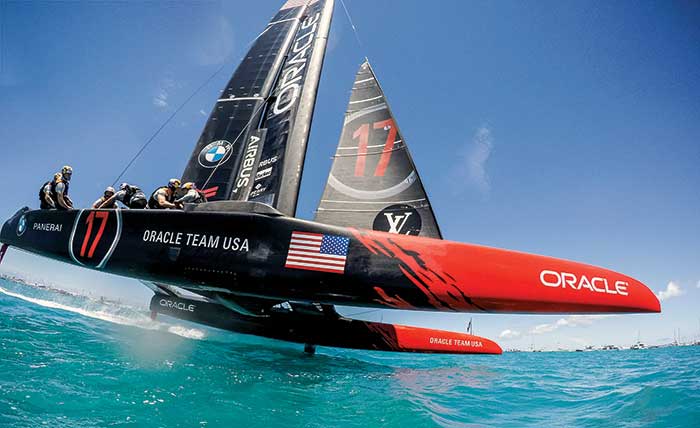
Oracle Team USA's AC50 "flying" at nearly 50 mph. (Photo: Ricardo Pinto)
Ever wonder why a sleek, powerful recreational boat is not even as fast as a typical economy car? It has to do with friction. An economy car needs a little over 100 horsepower to speed by at 100 mph, but pushing a boat through the water that fast takes several hundred horsepower. The reason is that water is almost 800 times denser than air.
Imagine standing on your dock in a 10-knot wind — it's not hard to do. Now imagine being in a river trying to stand up to a 10-knot current. The water is so much denser that no matter how strong you are, you'd be swept away. A boat hull has to push through all that dense water while a car can slip through the air much easier.
Planing boats are able to go faster than displacement boats because they lift part of their hull out of the water as they race over their bow wave, but there's still a lot of friction from the water on the rest of the hull. If you could get the hull all the way out of the water, you'd eliminate that friction, and the boat could go faster with the same amount of power.
The Science
Most of us have a pretty good understanding of how an airplane flies. As air flows over and under the wings (also called airfoils), it creates lift. Once an airplane is going fast enough, the lift that the wings create allow it to rise above the earth.
If you were to mount a wing or two (called hydrofoils) under a boat, all that dense water can be put to good use by pushing the boat's hull out of the water. Then friction only acts on the small foils, not on the whole hull, which is why a 130-foot hydrofoiling sailboat can "fly" at over 50 knots. Powerboats have added friction from the propulsion system that has to remain in the water, but even then, large hydrofoiling ferries can exceed 45 knots.
Speed is not the only advantage that hydrofoils give boats. Because the hull is out of the water, all the energy from waves that would normally pound against the boat pass harmlessly underneath it, creating an eerily smooth ride. Even so, hydrofoiling is typically best in somewhat protected waters.
Don't look for hydrofoils on your next runabout anytime soon because they're much more difficult to engineer and typically triple the cost of a boat. The good news is that there are other ways to 'foil that are affordable — see "Experience Hydrofoiling For Yourself" at below.
Experience Hydrofoiling For Yourself
Hydrofoil kiteboards.
If you've even seen a kiteboard zooming in a strong breeze, you know they're plenty fast. Add a hydrofoil, and suddenly you add a new dimension. These boards take lots of skill and practice to master, but the ride is said to be much smoother and even faster than a conventional kiteboard. Cost starts at around $1,000.
Hydrofoil Waterskis
These single-ski hydrofoils are really a sit-on-ski, and once you've mastered the technique, the foils will lift you up and you'll be "flying." Unlike conventional skis, these aren't designed for speed, and 18 mph is where they typically "liftoff' and suggested top speed is about 25 mph. It's also important not to ski in shallow water due to the depth of the foils. Cost is typically $1,500 and up.
Hydrofoil Windsurfers
Not content to take a surfboard and add a sail, windsurfers developed foils that allow the board to "levitate." The biggest advantage is the smoothness of the ride — a real benefit because these rigs usually sail in very strong winds with plenty of chop. Cost is about $2,500 to get started.
Hydrofoiling Small Sailboats
You don't have to spend millions on a boat like the America's Cup racers if you want to hydrofoil. The Waszp costs about $10,000, though even for dinghy racers, there's a learning curve to get these boats on their foils, with speeds up to 27 mph.
Note that most companies suggest wearing a helmet when using foiling products because of the speeds achievable and the hard, sharp foils these devices have.
Foiling The Competition
America's Cup boats are often what people think of when they hear the word "hydrofoil." Hal Youngren, an aeronautical engineer and one of the designers for the 2013 and 2017 America's Cup racers, says the difference in speed that foils make is impressive. The fastest nonfoiling catamarans in previous races could barely reach 35 knots, while the 2017 foiling cats hit 50 knots. Youngren says that these 50-foot cats are able to lift their hulls completely out of the water using only about three-quarters of a square meter of foil area (about the size of a medium-sized TV). Below about 15 knots, he says, the boats sail much like a nonfoiling boat with hulls in the water, but once over that speed, the boats start to "fly" and their speed dramatically increases.
The America's Cup Class AC75 Boat Concept Revealed
An exciting new era in America's Cup racing was unveiled in November 2017 as the concept for the AC75, the class of boat to be sailed in the 36th America's Cup is released illustrating a bold and modern vision for high performance fully foiling monohull racing yachts.
The America's Cup AC75 Boat Concept Revealed
The Emirates Team New Zealand and Luna Rossa design teams spent the previous four months evaluating a wide range of monohull concepts. Their goals have been to design a class that will be challenging and demanding to sail, rewarding the top level of skill for the crews; this concept could become the future of racing and even cruising monohulls beyond the America's Cup.
The AC75 combines extremely high-performance sailing and great match racing with the safety of a boat that can right itself in the event of a capsize. The groundbreaking concept is achieved through the use of twin canting T-foils, ballasted to provide righting-moment when sailing, and roll stability at low speed.
An underlying principle has been to provide affordable and sustainable technology "trickle down" to other sailing classes and yachts. While recent America's Cup multihulls have benefitted from the power and control of rigid wing sails, there has been no transfer of this technology to the rigs of other sailing classes. In tandem with the innovations of the foiling system, Emirates Team New Zealand and Luna Rossa are investigating a number of possible innovations for the AC75's rig, with the requirement that the rig need not be craned in and out each day. This research work is ongoing as different concepts are evaluated, and details will be released with the AC75 Class Rule before March 31, 2018.
The America's Cup is a match race and creating a class that will provide challenging match racing has been the goal from the start. The AC75 will foil-tack and foil-gybe with only small maneuvering losses, and given the speed and the ease at which the boats can turn the classic pre-starts of the America's Cup are set to make an exciting comeback. Sail handling will also become important, with cross-overs to code zero sails in light wind conditions.
A huge number of ideas have been considered in the quest to define a class that will be extremely exciting to sail and provide great match racing, but the final decision was an easy one: the concept being announced was a clear winner, and both teams are eager to be introducing the AC75 for the 36th America's Cup in 2021. — AmericasCup.com
Related Articles
The truth about ceramic coatings for boats.
Our editor investigates the marketing claims of consumer-grade ceramic coatings.
Fine-Tune Your Side Scan Fishfinder
Take your side-scanning fishfinder off auto mode, and you’ll be spotting your prey from afar in no time
DIY Boat Foam Decking
Closed-cell foam flooring helps make boating more comfortable. Here’s how to install it on your vessel
Click to explore related articles
Charles Fort
Contributing Editor, BoatUS Magazine
Charles Fort is BoatUS Magazine's West Coast Editor. He often writes local news items for BoatUS Magazine's Waypoints column and contributes to Reports, in-depth tech features in every issue written to help readers avoid accidental damage to their boats. He is a member of the National Association of Marine Surveyors, he's on ABYC tech committees, and has a 100-ton U.S. Coast Guard license. He lives in California.
BoatUS Magazine Is A Benefit Of BoatUS Membership
Membership Benefits Include:
Subscription to the print version of BoatUS Magazine
4% back on purchases from West Marine stores or online at WestMarine.com
Discounts on fuel, transient slips, repairs and more at over 1,200 businesses
Deals on cruises, charters, car rentals, hotel stays and more…
All for only $25/year!
We use cookies to enhance your visit to our website and to improve your experience. By continuing to use our website, you’re agreeing to our cookie policy.

Discover the Magic of Hydrofoil Sailboats

Last Updated by
Daniel Wade
December 11, 2023
Key Takeaways
- Hydrofoil sailboats blend speed, stability, and innovation for a fun sailing experience.
- Their design lifts the hull above water, reducing drag and enabling high-speed travel.
- Advanced control mechanisms maintain stability in varying wind conditions.
- Sails and hulls are meticulously engineered for optimal aerodynamics and lift.
- Ongoing innovations in foil technology continue to propel hydrofoils to new heights.
Based on their innovation and nature, the world of hydrofoil sailboats are magical, to say the least. But what exactly makes them so exceptional?
The magic of hydrofoil sailboats lies in their extraordinary speed. They can achieve remarkable speeds that were once thought impossible for sailboats. Their unrivaled stability and cutting-edge technology redefine sailing, offering a thrilling blend of innovation and performance.
Over the years, I've dedicated myself to mastering the intricacies of the yachting world, not just as an observer but as an active participant in the hydrofoil sailing community. My knowledge extends beyond the surface, encompassing the technical aspects of hydrofoil design and the thrill of high-speed sailing. As such, I’ll provide a comprehensive and engaging exploration of what sets hydrofoil sailboats apart, making them truly magical on the waters.
Table of contents
Discover the Magic of Hydrofoil Sailboats
Hydrofoils saw their early development as a concept for enhancing speed and efficiency on the water. From Alexander Graham Bell's experiments to the application of foils on sailboats in the 1950s, the quest has always been for greater speed.
But it wasn't until Russell Long championed these designs with the CEC foiling catamaran and the development of the Hobie Trifoiler that hydrofoils began to carve a distinct niche in the sailing world.
This sailboat operates on a simple yet ingenious principle: as the speed increases, the foils submerged beneath the boat generate lift. This lift thrusts the boat's hull above the water, dramatically reducing drag.
It’s similar to how air flows around the wing of an airplane, only with water's denser environment offering a different dynamic. This revolutionary foiling system allows boats to glide over waves, offering an incredibly smooth ride.
The variety of hydrofoil sailboats is astounding, from the foiling catamarans that have revolutionized the America's Cup to the twin sail trimaran designs. The fastest production sailboat, the Hobie Trifoiler , showcases what hydrofoils are capable of.
Additionally, boats like the innovative Emirates Team New Zealand vessels continue to push the boundaries of technology in competitive sailing. Whether for recreational purposes or high-speed racing, the range of hydrofoil sailboats caters to different sailing experiences and preferences.
Now, let’s explore the various aspects of hydrofoil sailboats that make them truly magical.
The Thrills of Hydrofoil Sailing
When I first stepped onto a hydrofoil sailboat, I knew that sailing would never be the same for me. Harnessing the power of the wind to achieve remarkable speeds while hovering above the water was nothing short of revolutionary.
It's an adrenaline-infused blend of sailing, flying, and innovation that promises high performance and stability with a significant reduction in wetted areas.
The allure of hydrofoiling is not just about the speed; it's the sensation of flying over the waves, defying the conventions of traditional sailing. With each gust, my hydrofoil sailboat becomes a silent, swift car, slicing through the air rather than merely sailing on the water.
When sailing with hydrofoils, you get to experience the following benefits.
- High Speed: With hydrofoils, I've seen and achieved speeds I never thought possible on water.
- Less Wetted Area: As the hydrofoils lift the hull out of the water, drag is reduced, further contributing to the craft's efficiency and speed.
- Stability: Surprisingly, the flying sensation is accompanied by stability once airborne, making the ride smoother.
The America’s Cup Competitive Foiling
Over the years, I've witnessed first-hand how hydrofoil technology has radically altered the landscape of competitive sailing. The introduction of hydrofoils has not only redefined what we consider possible in the sail area but has also brought a fresh surge of excitement to the racing circuit.
The most illustrious event in sailing, the America's Cup , underwent a transformation with the embrace of hydrofoils. Emirates Team New Zealand, a frontrunner in hydrofoil innovation, redefined the America's Cup racing in 2017.
Alongside them, the US team and Luna Rossa played pivotal roles in reshaping the landscape of America's Cup racing.
With their AC50 class catamarans soaring above the waves at top speeds that defy traditional sailing limits, they clinched the title and shifted the focus of competitive racing toward technological prowess.
The spectacle of these vessels racing is not just about the crew's capabilities but equally a testament to engineering marvels.
Also, the advent of hydrofoils in racing has certainly led to a spike in performance metrics. Here's a concise table highlighting the before and after impact of hydrofoiling in competitive Sailing:
This table illustrates just how much the racing landscape has shifted; it's not only sailing anymore.
It’s similar to piloting a high-speed aircraft, with each crew member playing a crucial role in harnessing the raw power of the strong winds in harmony with state-of-the-art technology. Watch this video for a more detailed explanation of hydrofoil sailboats and their magical power.
Technical Aspects of Hydrofoil Sailboats
In diving into the technical aspects of hydrofoil sailboats, I'll give you an insight into the intricate designs that enable these marvels to glide above the water, as well as the cutting-edge foil technology propelling them.
The design of a hydrofoil sailboat revolves around its capability to elevate the hull above the water, reducing drag and enabling high wind-speed travel. Control mechanisms are central in maintaining stability, especially when the sailboat interacts with varying wind conditions or maneuvers through shallow waters.
The hull's length and overall design are calibrated for balancing aerodynamics with hydrodynamics. In designing sails and hulls for foiling, one must carefully balance the need for power with the propensity for lift.
The sails are tailored not only to harness the wind's energy effectively but also to match the unique mechanics of a vessel in flight. Meticulous engineering ensures that the sail configuration works in harmony with the foils to propel the sailboat forward swiftly.
Additionally, the foil technology, which is pivotal to modern hydrofoils, has undergone significant further development over the years . From the materials used to the manufacturing processes, every element incorporates the latest in technology to yield extreme performance.
Advancements have led to foils that can automatically adjust to sailing conditions and speed, which is instrumental for achieving and maintaining high speeds.
Currently, the future of hydrofoil technology seems bound for even further breakthroughs. Customization and refinement of foils for specific water conditions, such as the challenges posed by shallow water, are ongoing.
Each new iteration builds upon the last, consistently advancing the field and informing the next leap in hydrofoil sailing. This persistent innovation in foil and hull technology is a testament to the potential that lies ahead for hydrofoil sailboats.
Are Hydrofoil Sailboats the Right Options for You?
Hydrofoil sailboats offer a unique and thrilling sailing experience, but whether they are the right option depends on your preferences and goals. These high-performance vessels are known for their exceptional speed and stability, making them ideal for thrill-seekers and competitive sailors.
If you're passionate about cutting-edge technology and want to push the boundaries of traditional sailing, hydrofoil sailboats could be a perfect fit.
However, they may require a learning curve for beginners and are typically more expensive than traditional sailboats.
Consider your skill level, budget, and desire for speed and innovation when deciding if hydrofoil sailboats align with your sailing aspirations.
The Future of Hydrofoil Sailboats and Their Transformative Potential
Over the years, I've been captivated by the evolution of sailing and the recent advancements in hydrofoil technology, which promise a thrilling future for these marine crafts.
The technology supporting hydrofoil sailboats is rapidly advancing, bringing us closer to a world where boats gliding above the water's surface is a common sight.
These boats use 'wings' or foils submerged in water to lift the hull above the surface, reducing drag and allowing for greater speeds. This innovation is not just limited to racing but is expected to influence recreational and transport vessels in the future.
Today, we see hydrofoils in action with hydrofoil kiteboards, which have become popular among thrill-seekers. This is due to their ability to harness wind power and achieve impressive acceleration and agility on the water. This same principle is being applied to larger sailing vessels, where performance and sustainability converge.
The further development of hydrofoil technology involves intensive research into materials and design optimizations that can handle the challenges of varied sea conditions.
Electric and solar-powered hydrofoils are on the horizon, poised to significantly impact our world by offering greener alternatives to traditional boats.
Notably, the trends in hydrofoiling indicate a shift towards more sustainable sailing, utilizing advancements in electric propulsion systems to complement the inherent energy efficiency of hydrofoil designs.
The goal is a fleet of sailboats that are not just faster but more eco-friendly, promising an exciting future where the joy of sailing is in harmony with the health of our oceans.
Related Articles
I've personally had thousands of questions about sailing and sailboats over the years. As I learn and experience sailing, and the community, I share the answers that work and make sense to me, here on Life of Sailing.
by this author
Learn About Sailboats
Most Recent

Affordable Sailboats You Can Build at Home
September 13, 2023

Best Small Sailboat Ornaments
September 12, 2023
Important Legal Info
Lifeofsailing.com is a participant in the Amazon Services LLC Associates Program, an affiliate advertising program designed to provide a means for sites to earn advertising fees by advertising and linking to Amazon. This site also participates in other affiliate programs and is compensated for referring traffic and business to these companies.
Similar Posts

Hunter Sailboats: Are They Built for Bluewater Cruising?
August 29, 2023

What Is A Furler On A Sailboat?
August 22, 2023

What Is Sail Roach?
August 15, 2023
Popular Posts

Best Liveaboard Catamaran Sailboats
December 28, 2023

Can a Novice Sail Around the World?
Elizabeth O'Malley
June 15, 2022

4 Best Electric Outboard Motors

How Long Did It Take The Vikings To Sail To England?

10 Best Sailboat Brands (And Why)
December 20, 2023

7 Best Places To Liveaboard A Sailboat
Get the best sailing content.
Top Rated Posts
Lifeofsailing.com is a participant in the Amazon Services LLC Associates Program, an affiliate advertising program designed to provide a means for sites to earn advertising fees by advertising and linking to Amazon. This site also participates in other affiliate programs and is compensated for referring traffic and business to these companies. (866) 342-SAIL
© 2024 Life of Sailing Email: [email protected] Address: 11816 Inwood Rd #3024 Dallas, TX 75244 Disclaimer Privacy Policy
- 2024 BOAT BUYERS GUIDE
- Email Newsletters
- Boat of the Year
- 2024 Freshwater Boat and Gear Buyers Guide
- 2024 Boat Buyers Guide
- 2024 Water Sports Boat Buyers Guide
- 2023 Pontoon Boat Buyers Guide
- Cruising Boats
- Pontoon Boats
- Fishing Boats
- Personal Watercraft
- Water Sports
- Boat Walkthroughs
- What To Look For
- Best Marine Electronics & Technology
- Watersports Favorites Spring 2022
- Boating Lab
- Boating Safety

Using a Hydrofoil to Improve Efficiency
- By Alan Jones
- Updated: July 15, 2021
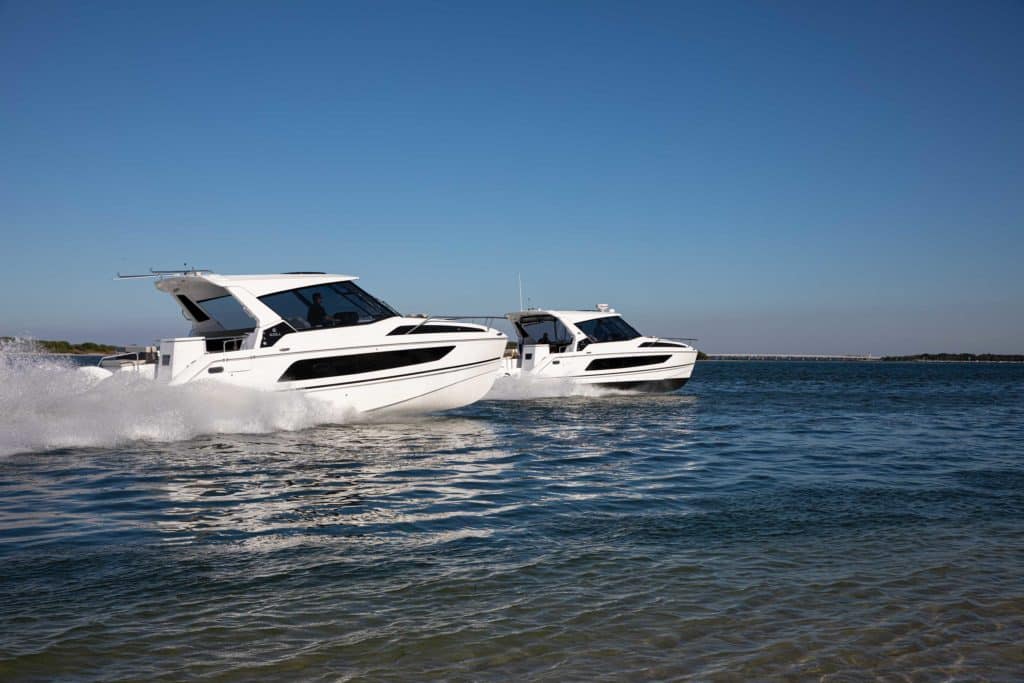
It’s hard to believe a piece of metal with no moving parts can be the approximate equivalent of adding 200 horsepower, 100 gallons of fuel and 100 miles of extra range. But when it’s a hydrofoil attached between the hulls of an Aquila 36 Sport power catamaran (above, far right), that’s the net effect.
While the efficacy of foiling boats is well-documented, this technology has surprisingly had little impact on the recreational powerboat market. Hydrofoils that lift a hull entirely out of the water seem to be too alien to most boaters. Plus, most foil designs require dynamic control using computers to remain aloft at a constant elevation. But they are proven to be effective. With the Aquila 36 Sport, we experienced its benefits on a recreational boat and compared it in real time to the same boat without a foil but with 200 extra ponies. Here’s what we found.
Hydro What?
Gino Morrelli and Pete Melvin, of Morrelli and Melvin Design and Engineering, applied their decades of foiling experience to design the Hydro Glide Foil System for Aquila. It consists of a main hydrofoil attached slightly aft amidships to each hull and the top of the tunnel. It lifts approximately 40 percent of the hull’s weight out of the water when at cruise speeds, for better performance and fuel economy. Farther back, twin fins act like an airplane’s horizontal stabilizers to prevent porpoising at higher speeds. What makes hydrofoils so effective is the dramatic reduction in drag. A typical planing hull has a 4-to-1 lift-to-drag ratio, while a hydrofoil can have up to a 25-to-1 lift advantage.
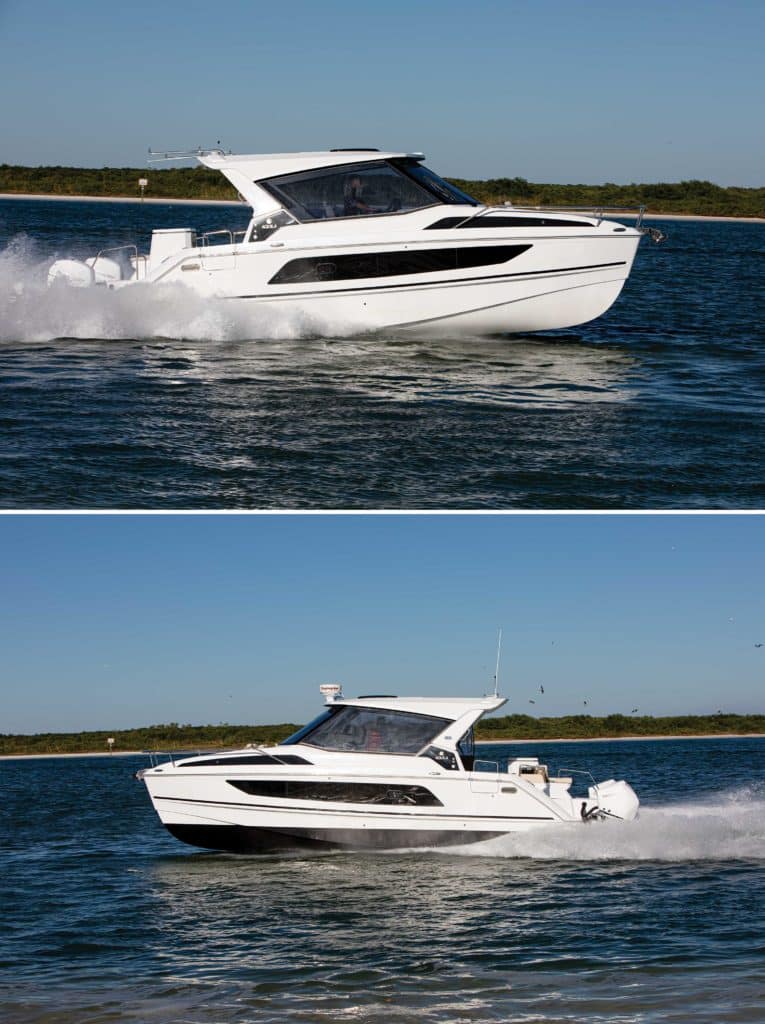
How does it work? The fields of aerodynamics and hydrodynamics are kissing cousins, so many of the principles of one apply to the other. The silhouette of a typical asymmetric hydrofoil wing wouldn’t look out of place on a 737. It consists of a convex curve on the upper side and a flatter bottom side. These taper down toward the rear. Bernoulli’s principle explains that when air or water rushes over the top side of a wing, the medium has to travel farther, so it moves faster. This creates lower pressure on top, allowing the higher pressure on the bottom to push upward.
Sir Isaac Newton’s third law also applies to hydrofoils. The simplified version says that for every action, there is an equal and opposite reaction. So, if a foil is directing the water down, it’s pushed back and the foil rises, creating lift. This effect is enhanced by an increased angle of attack at the leading edge to create more lift. In the case of Aquila’s Hydro Glide foil, it will still provide lift even if the boat’s bow is pointing down 3.5 degrees, which will be useful when running down-sea because it avoids transforming the hydrofoil into the equivalent of a down-planer or sea anchor.
Too much lift can also be a problem, according to Alain Raas, brand manager for Aquila Boats. “Because water is denser, a hydrofoil creates about 830 times more lift for the same area and speed compared to an airplane wing, so you can use a much smaller foil in water than air,” Raas says.
Most hydrofoils operate near the surface and can ventilate, which is a phenomenon that occurs when the low-pressure side of a foil pulls air from the surface and destroys lift on the foil, Raas explains. “Foil depth, sweep, dihedral and section shape all play a significant role in avoiding ventilation,” he adds.
Dueling Aquilas
We were able to arrange a test staging out of MarineMax in St. Pete Beach, Florida. MarineMax is Aquila’s exclusive distributor in the US. The Aquila brand is owned by the Sino Eagle Group, a high-tech Chinese builder that extensively uses vacuum-infusion technology to build the boats. J&J Design Group provided a complete design package for the Aquila 36 Sport.
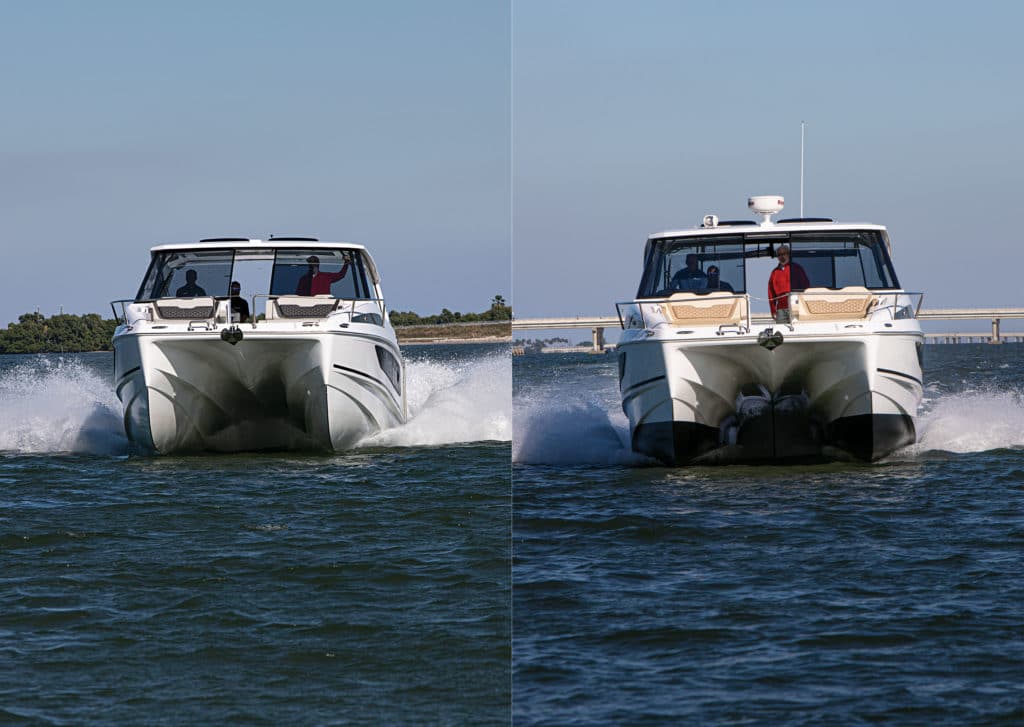
Aquila is largely the brainchild of Lex Raas, Alain’s father and president of Aquila at MarineMax. Lex is South African, and his career journey has taken him from working for Beneteau (the world’s largest boatbuilder) to the Moorings (the world’s largest vacation charter operation) to MarineMax (the world’s largest boat dealer). While a big believer in power catamarans for their roominess and comfort, Lex didn’t like that most were converted sailing vessels. The unveiling of the Aquila 36 Sport power catamaran in 2017, the company’s first outboard-powered model, ushered in a new era of high performance. Because these boats would be used on bareboat charters driven by skippers of varying degrees of expertise, they are purposely designed to be easy to pilot.
One Cool Cat
Our first sea trial began aboard the nonfoiled Aquila, joined by Alain Raas and Jacob Coyle, a MarineMax sales associate. When we headed out into the Gulf of Mexico through the Pass-a-Grille entrance, the wind was blowing 17 mph and gusting to 23 mph from the northwest, creating steep 4-foot waves. In other words, it was a glorious cat day.
Our nonfoiled test boat was powered by a pair of Mercury Verado 400 outboards derived from the Mercury Racing division. This engine does some serious overachieving given its smallish 2.6L inline-six-cylinder block, thanks to twin-scroll superchargers, which lend it substantial punch when a driver needs a blast of power. Ultra-rapid acceleration is less important for catamarans, which usually do best in rough water when kept at a steady speed that is faster than you would think.
Read Next: Aquila 36 Test
The big difference between most power cats and the 36-foot Aquila 36 Sport is the Aquila’s incredible 14-foot-7-inch beam, which creates a living room’s worth of space in the cockpit/salon for up to 26 passengers and is mostly enclosed by an optional hardtop. In addition to helping its optional Joystick Docking for Outboards system work more efficiently, this wide footprint creates an ultra-stable platform that will be reassuring to those without sea legs (or stomachs). It’s so stable, according to Alain, no customers have ever asked Aquila to install a Seakeeper gyrostabilizer.
Settling into a cruise speed of 33 mph felt like the cat’s happiest velocity for that sea state. The narrow profile of the twin hulls cleaved the water without the pounding that characterizes most monohulls when running into steep waves. We used a little bit of engine trim to bring the bow of the hulls out of the water to reduce drag and prevent bow steering, and the boat offered a smooth ride, even when we turned the beam to the waves. Narrower cats of similar lengths can snap-roll alarmingly in large beam seas, but the Aquila remained surprisingly level.
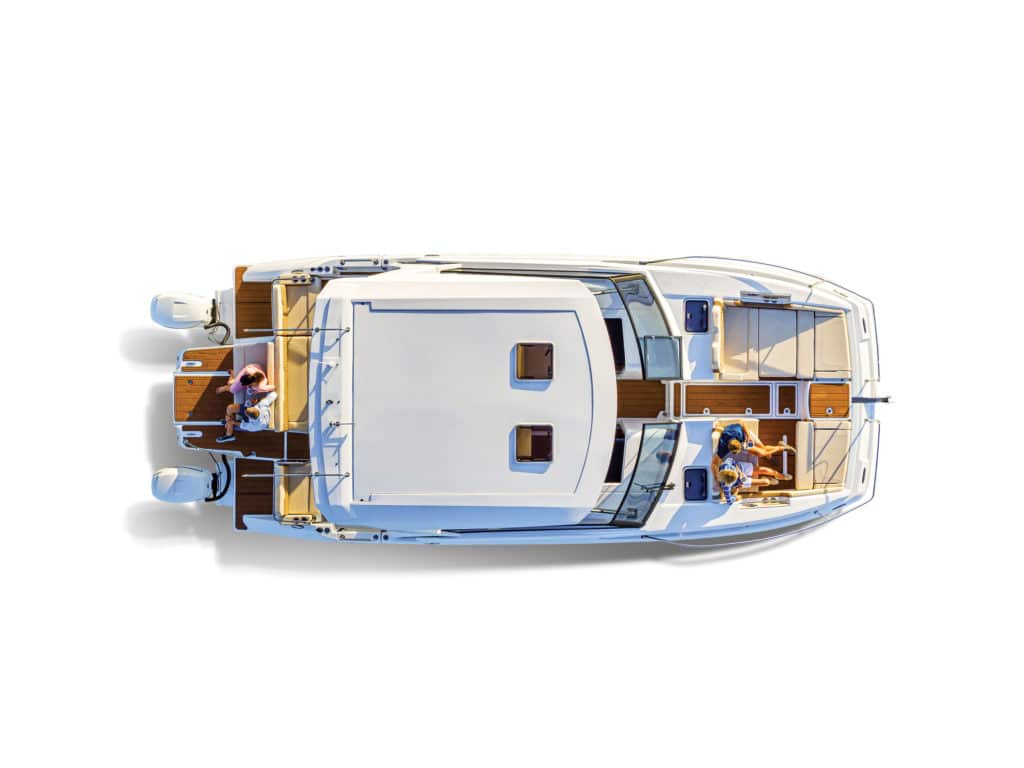
Heading into Bunces Pass is tricky because of shoaling on each side, but once through, it put us squarely into the Tampa Bay area’s recreational boating epicenter. With Egmont Key State Park and Fort De Soto Park to starboard and Shell Key Preserve to port, we were surrounded by great beaches that are perfect to nose up to. The Aquila 36 Sport Hydro Glide showed off its ability to float in just 2 feet of water with the engines trimmed up as we beached it. We beached the foil boat too. Even though the bottom of the foil is about a foot lower than the hulls, its extruded aluminum construction is stout enough to withstand being gently beached.
Time to Fly
Switching boats, we were curious to feel the difference the foil makes. The experience was subtle. The Hydro Glide foil is positioned just forward of the boat’s longitudinal center of gravity and set at zero degrees of attack, allowing the driver to use engine trim to increase the angle for optimal lift. On this boat, little trim is needed because the optimal angle of attack of the hydrofoil is only about 1.5 degrees, according to Lex. In our case, because the fuel tanks were almost full, we just trimmed the engines to their neutral position and let the weight of the fuel give the Aquila 36 Sport Hydro Glide its proper bow-up angle.
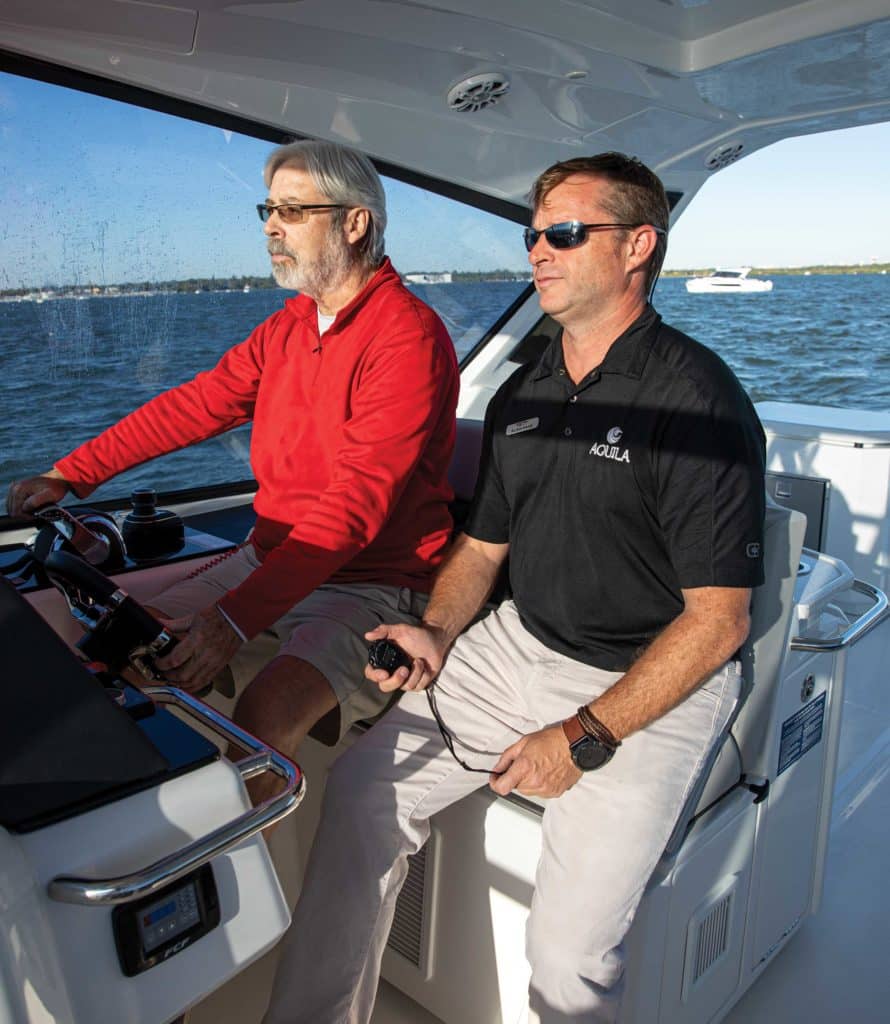
Because the Hydro Glide Foil System lifted the hull only about 6 inches, there was a general feeling of riding higher in the water, but the most tangible evidence was how the steering felt lighter and more responsive—an indication that the foil is running at its proper angle of attack. The wake behind us flattened out significantly, unlike the tall rooster tail and wake that shot aft from the nonfoiled boat. Offshore, it handled the steep chop well and felt best at a cruise speed of 38 mph. There was never a moment when it lost its lift from the foil.
Another difference lay in the cornering characteristics. Without the foil, the 36 Sport has a slight lean to the outside, which some find off-putting. With the Hydro Glide foil, the cat leaned slightly inward and felt nimbler as it carved hard turns. A driver can overcook it during extremely hard turns—the hulls can dig in and turn more sharply than expected—so whipping it into a corner like it’s a jet boat isn’t advised.
Foils that raise a boat’s hull entirely out of the water can plummet should the boat lose lift. But the dihedral V-shape of the Aquila’s foil allows it to descend a little at a time when exposed above the water. This results in gentle corrections in heave, or a boat’s up-and-down motion.
The Numbers Don’t Lie
The Aquila 36 Sport Hydro Glide reached plane in 6.4 seconds, which was 1.4 seconds faster than the nonfoiled boat. Its zero to 30 mph time was 2.4 seconds quicker, taking 12.4 seconds. While those might sound like modest gains, remember this test boat had twin 300 Mercury Verado engines—200 fewer horses than the nonfoiled boat. Of course, these 300s are the new-generation Mercury V-8 engines, featuring 4.6L in a naturally aspirated design instead of the 400′s 2.6L twin-supercharged powerplant. Having two more cylinders and 2 liters of increased displacement negates the need for supercharging because big blocks inherently have more low-end torque.
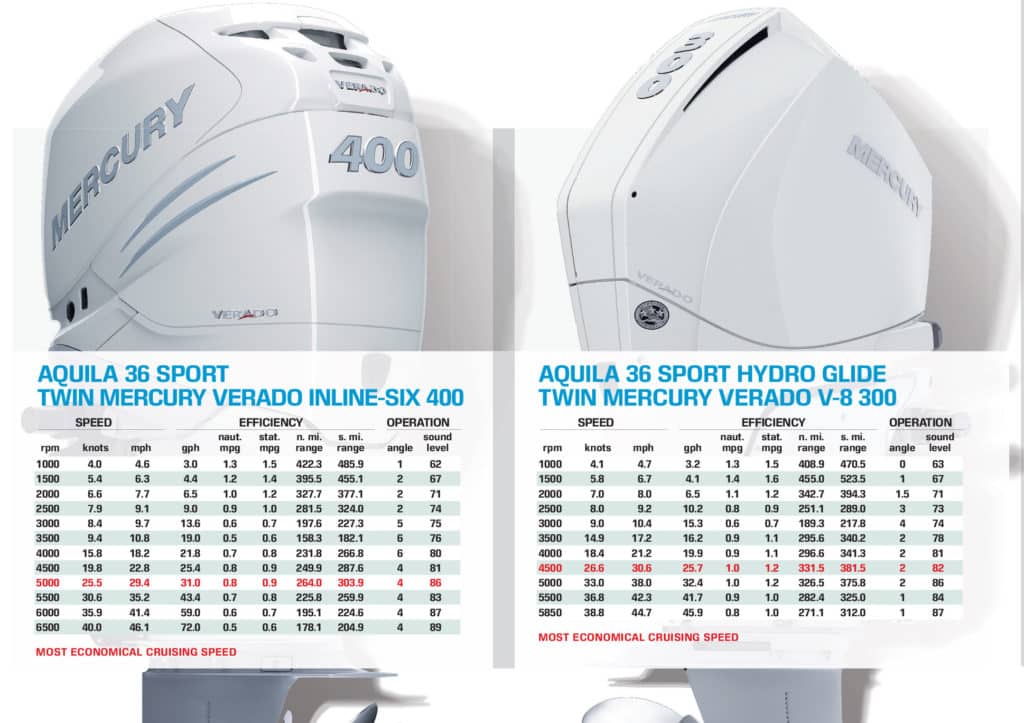
Most impressive was the lack of penalty for going fast on the 36 Sport Hydro Glide. Even at its top speed of 44.7 mph, it was still getting nearly 1 mpg, and the effect on its range was dramatic. At that speed with a full 356-gallon tank, we could theoretically travel the 322 miles from St. Pete Beach to Havana, though exceeding our 10 percent reserve. The nonfoiled Aquila 36 Sport, traveling at its top speed of 46.1 mph, would fall well short of reaching Key West (231 miles away) with a full tank. At its best cruise speed of 30.6 mph, the hydrofoil-equipped Aquila can go 381.5 miles, compared to the nonfoiled version’s 303.9-mile range, when traveling at 29.4 mph, factoring in a 10 percent reserve.
At first blush, opting for the Hydro Glide Foil System might cause sticker shock with its $32,452 price tag, which equates to running through about 13,000 gallons of fuel at $2.50 per gallon to recoup the investment. But if you factor in the difference in buying a pair of 300s versus 400s, the price is much closer, and you get a better-handling boat with more capability because of its increased range. Aquila 36 Sport owners will be happy to discover the Hydro Glide Foil System can be retroactively fitted at an estimated additional labor cost of $10,000. Twin 300s are the max power with the foil because higher speeds cause cavitation, which then adds drag. But the improvements in ride, acceleration and range make this the biggest no-brainer on the options list.
- More: Aquila , Boats , Cruising Boats , versus
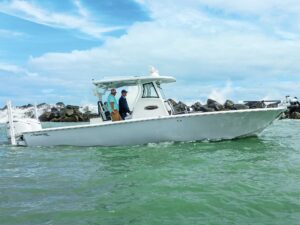
Boat Test: 2024 Tidewater 3100 Carolina Bay
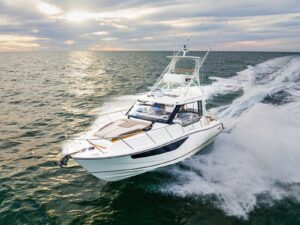
Boating On Board: Boston Whaler 365 Conquest
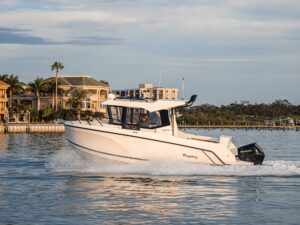
Boat Test: 2024 Bayliner Trophy T23 Pilothouse
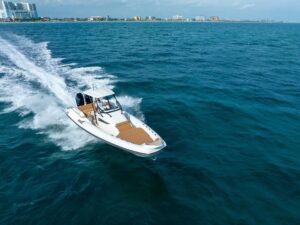
Boat Test: 2024 Nuova Jolly Prince 33 CC
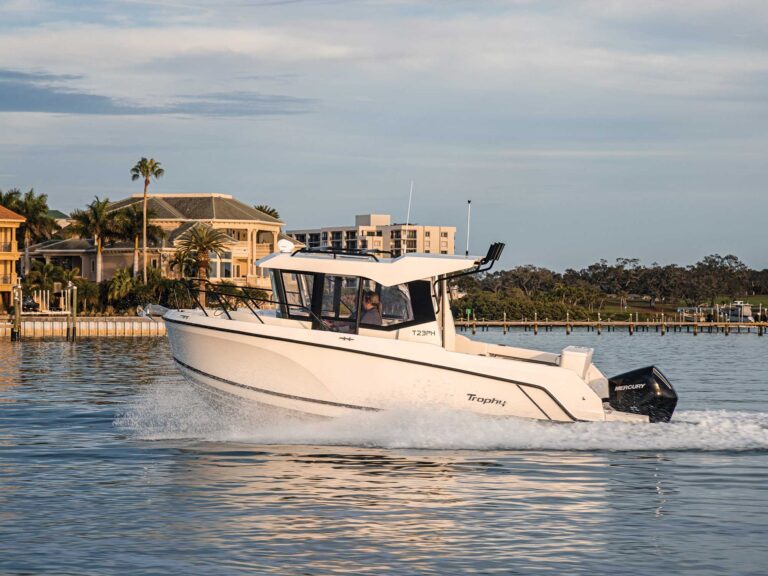
What to Do if Your Boat’s Engine Dies
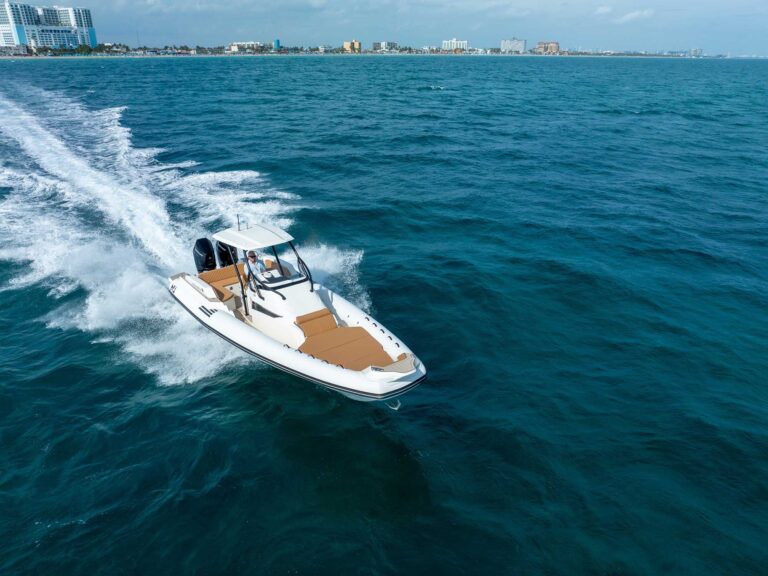
ProTournament Elite Gen 3 Chargers

- Digital Edition
- Customer Service
- Privacy Policy
- Cruising World
- Sailing World
- Salt Water Sportsman
- Sport Fishing
- Wakeboarding
Many products featured on this site were editorially chosen. Boating may receive financial compensation for products purchased through this site.
Copyright © 2024 Boating Firecrown . All rights reserved. Reproduction in whole or in part without permission is prohibited.

Hydrofoil Boats (Everything You Need to Know)
Despite the technology being around for over a hundred years, hydrofoil boats have once again become a hot topic amongst boat enthusiasts. Hydrofoil technology enhances both speed and efficiency of water vessels, and has been used by US Navy watercrafts, superyachts, racing boats, ferries, and many more.
A hydrofoil boat is supported by a winglike structure that creates lift as the boat’s speed increases. This makes the boat faster and smoother by reducing drag and keeping the boat above the waves.
With hydrofoil boats making headlines once again, it’s time to go over what they are, how they work, their advantages, disadvantages, and a serious evaluation on whether they are the future of boating or not. In this article, we’ll go over all there is to know about hydrofoils.
Table of Contents
What is a Hydrofoil Boat?
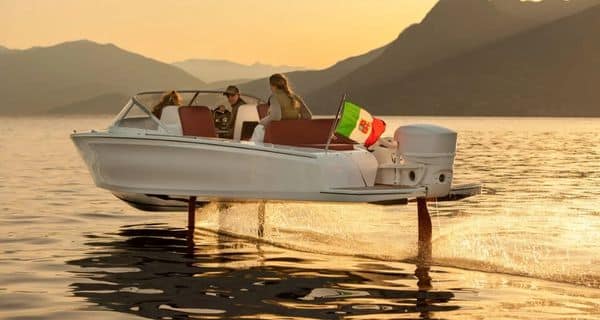
A hydrofoil boat is supported by a “hydrofoil” which is a structure composed of either a wing (V), T, or U shape. There are two types of hydrofoil boats: surface-piercing, and fully submerged. Both types of hydrofoils achieve the same purpose of lifting the boat off the surface of the water at high speeds.
When going fast enough, the lift of the foils is great enough to lift the entire hull of the boat out of the water, so that nothing but the foils themselves are touching the surface. This has some incredible benefits in terms of speed, efficiency, and experience – all of which we will soon go over.
Hydro foils help minimize drag and improve speed which is very similar to the effects achieved by aerofoils used on airplanes.
Hydrofoil boats are powered mainly in the same way other power boats are, by propellers or water jets. With that being said, they are also really popular in sailing. But the use of hydrofoils on sailboats is highly technical and primarily used by racing teams. They are most commonly used by commercial boats, and now are being introduced at the consumer level with pleasure boats.
History of the Hydrofoil Boat
The hydrofoil technology was first developed by inventors Casey Baldwin, Enrico Forlanini, and Alexander Graham Bell – yep, the same guy who invented the telephone. Forlanini had a prototype operating on Lake Maggiore in Italy by 1909. The hydrofoil boat achieved fame in WWII when it was used by both the German and US Navy to navigate waters that were heavily guarded by mines.
During the 1960s, 70s, and 80s, the hydrofoil technology was taken to water sports, where it was used in kiteboards, surfboards, and the air chair. It returned to the consumers’ attention in the 2010s, when it was used by racing teams across the world to set speed and time records in sailing championships. Most recently, watercraft companies have begun experimenting with the idea of hydrofoils on smaller scale boats outfitted with propelled and outboard engines.
How does a Hydrofoil Boat work?
So, we know that hydrofoils help boats achieve higher speeds with less drag, but how does that really work? The best way to think of it would be as “a boat with wings,” as that is essentially what they are. Just like an airplane would lift off the ground or water, as a hydrofoil boat gains speed, it lifts off the water too. While the foils themselves are submerged in the water still, much of the time there is enough lift to hold the entire hull of large ships and ferries off the surface. The sensation of being in a hydrofoil boat is much like being in an airplane that has limited flight. It’s smooth, and it’s really fast.
At the consumer level, hydrofoils require additional technology. As we’ll go over later on, this can result in some expensive price tags. As you can imagine, a boat that essentially “flies” through the air comes with some safety hazards. Hydrofoils require an automatic control system that maintains flying height, foil pitch, and smoothness of the ride. This “autopilot” system allows the foil to move in and out of the water safely, preventing the boat from slamming back into the water after it’s been lifted off the surface.
Hydrofoil Boat Advantages and Disadvantages
Their speed and unique ability to shed drag is undeniable, but are hydrofoils really all they are cracked up to be? In this regard, there are several advantages and disadvantages to consider.
Hydrofoil Advantages
- Speed: No surprise here. Most hydrofoils whether in the form of sailboat, ferry, or commercial vessel, can “fly” at speeds well over 50 knots (60 mph).
- Comfort: Because the hull of the boat is off the water, most waves and wakes hardly impact the boat, and therefore go largely unfelt by passengers. This makes for one smooth ride.
- Stabilization: For the same reason that comfort is increased, so is the boats stability (at high speeds that is). The hydrofoils cut through the water, decreasing the motion index of the watercraft.
- Efficiency: Since they aren’t impacted by smaller waves and wakes that would slow the progress of most boats, hydrofoils reach their destination in a much more efficient manner. For boats powered by traditional propeller or jet engines, this efficiency promotes a substantially better fuel economy.
- Experience: The reduced drag and impact from waves makes for a one-of-a-kind boating experience. It truly does feel like you are “flying” just above the surface of the water.
Hydrofoil Disadvantages
- Skill: Operation of a hydrofoil is a lot more technical, and requires a much more advanced skillset when compared to that of a standard runabout boat.
- Water Type: Hydrofoils are only suited for the open sea or large lakes (as of now). They are NOT fit for shallow water, as any bottom strikes while in motion could prove to be catastrophic for both the riders and the boat itself.
- Speed Range: Hydrofoils are built to “fly,” but only at certain speeds. Each boat will have a speed range where it likes to operate. Anything below that range will result in extra drag because the hull and the foils are submerged in the water. Anything above the range gets to be dangerous and uncontrollable.
- Maintenance Costs: The more complex technology comes with more complex maintenance and storage.
- Total Cost: They aren’t cheap. Some of the more popular boats at the consumer level cost upwards of $300,000.
While they may prove to be more complicated in terms of where you can drive them and their cost, there is an undeniable “coolness” factor with hydrofoil boats. As they gain popularity around the world, industry experts believe their cost and availability will become more and more accessible.
Hydrofoil Boat Costs
While you can find hydrofoils in nearly every style of boat, in this article we will cover the most common types of “personal” watercraft. You can find more information on commercial hydrofoils through this article by ScienceDirect.
- Price: $329,000
- Power Specs: 67 hp, 44 kWh battery, capable of cruising at 20-30 knots.
** One important sidenote to make about the C-8 is the incredible C-POD electric motor, which requires much less energy than a traditional internal combustion engine. The manufacturer promises 4,000 hours without any maintenance. That’s nearly 20 years of consistent use without maintenance!
- Price: $900,000 (base price)
- Power Specs: 740 hp supported by twin V8s, providing for cruise speeds upwards of 40 knots.
- Price: $240,000
- Power Specs: 40 hp, 40 kWh battery, capable of cruising at 22 knots
** For a more in-depth review, check out this Youtube video:
- Candela C-7 Review
The Future of Boating?
There are some undeniable advantages that hydrofoils have over general powerboats. The lift they get off the water not only makes for less drag and more speed, but also promotes a more comfortable and efficient ride. With that being said, their cost in manufacturing and maintenance has made them more costly than most people can afford.
It’s hard to say whether or not hydrofoils will be more commonplace at the consumer level. Right now, they are really just a fun toy for the wealthy. There are also some operational issues that manufacturers need to overcome before you’ll see them on your local waterway. Their susceptibility to damage in shallow water makes them unfit for anything but a large lake or open sea. Hydrofoils may not be as common as your run of the mill jet boat yet, but their popularity is growing at a rapid pace. If your local water happens to be a giant lake or open ocean, don’t be surprised if you start seeing more of them!
- Recent Posts
- What Is The Cheapest Way To Store A Boat? - February 28, 2023
- Do Boats Need Bottom Paint? (Uncovering the Truth) - February 2, 2023
- How Much Is Bass Boat Insurance? (Real Quotes) - January 18, 2023
- Vessel Reviews
- Passenger Vessel World
- Offshore World
- Tug and Salvage World
- Maritime Security World
- Specialised Fields
- Marine Projects World
- Small Craft World
- Tanker World
- Dry Cargo World
- Boxship World
- Aquaculture World
- Trawling World
- Longlining World
- Seining World
- Potting World
- Other Fishing Methods
- Regulation & Enforcement
- Feature Weeks
- Classifieds
- Book Reviews
FEATURE | The future of hydrofoils
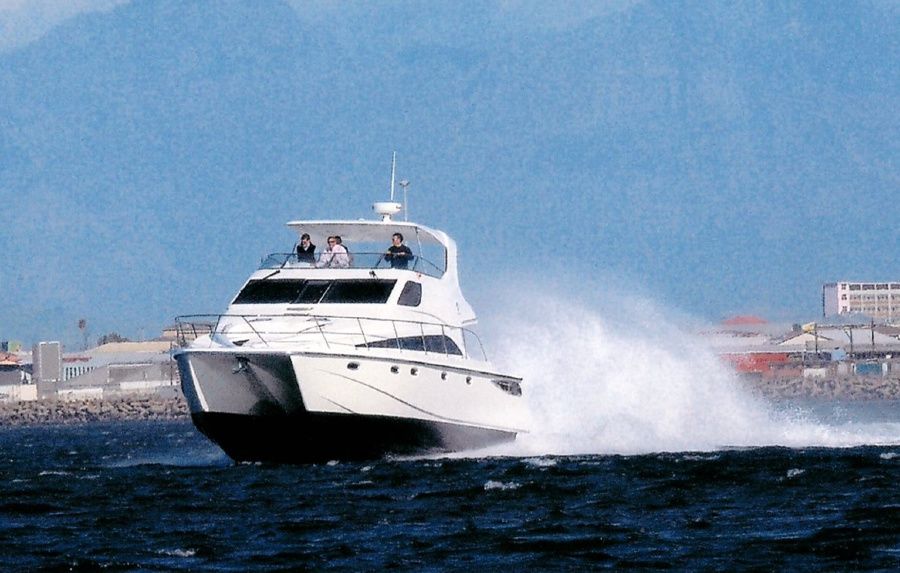
The following is the presentation given at the fiftieth anniversary virtual symposium of the International Hydrofoil Society (IHS) by Professor Karl Gunter Wilhelm Hoppe – naval architect at the Technical University of Berlin, Emeritus Professor at Stellenbosch University in South Africa, and director at Foil Assisted Ship Technologies.
Hydrofoils are hybrids of a planing monohull with a foil system. Hydrofoils were developed over 100 years now with some high-tech applications in the 1960s and 1980s.
The fact that the IHS still exists means there is still strong public interest in hydrofoil development even though they are not anymore in the public news.
However, some of the later hydrofoils are still in operation in certain countries and especially the Russian river hydrofoils. And yet the talk still goes around that hydrofoils are “drying out” and becoming relics that belong in museums.
Inevitably, a question has arisen after so many years have passed without virtually any new hydrofoils being built: Did we run out of experts to design hydrofoils and build them?
The clear answer is no, as hydrofoil systems have strong applications in sailboats now with extremely high tech applications reaching over 50 knots in much slower winds.
However, these are mainly sport sailboats. Why then did the hydrofoils seem to disappear?
One has to look carefully at the design of hydrofoils to find out what the real reasons of their neglect could be and find out what restraints are involved as well as the associated costs.
The two photos below show examples of hydrofoils.

There are many different foil forms and combinations with monohulls.
There are V-shape foil systems, flat type foils and deeply submerged foils; mostly all foils come in pairs for longitudinal stability. The fundamental design concept behind all hydrofoils is the idea that the foil must carry the full load weight of the craft, driving the hull out of the water and letting the foil carry all the weight with the hull being carried as deadweight, which is only there to supply sufficient buoyancy at rest and low speed.
The request for safe stability complicates the hydrofoils and this led to various ways, either to have fixed foil systems with the V-foils piercing the surface or later developments with full submerged foils and angular automatic foil control which ended up in the Boeing hydrofoils’ high-tech wave scanning system as used in aircraft – which increases costs considerably.
Another design request concerns the operation in open sea waves to let the hydrofoil platforming, which means it is not following the wave surface contour but runs on a horizontal plane. This required the foils to be deeply submerged with long struts to transmit the full weight force into the hull, which is not supposed to have any water contact when the hydrofoil is “foilborne.”
These foils and struts were of solid high tensile steel and had to have polished surfaces as the foils lose efficiency when the surfaces are rough. In seawater, especially in warm, tropical areas, foils needed to be kept clean of fouling.
All these restraints led to expensive craft and high maintenance costs.
Propulsion systems are challenging with very long propeller shafts and low OPC data. To get the hydrofoil rising at start speed, considerable power is required before it becomes foilborne.
In very bad weather only very slow speed can be used with bad efficiency and bad sea-keeping due to the low deadrise of hull. Turbine and air propulsion have low efficiency.
Hydrofoil wings at very high speed have to be extremely slender with low thickness over chord to prevent cavitation. Such wings are highly stressed and bends and struts are required to carry the ship’s weight load.
These struts create additional resistance reducing craft efficiency. They also increase ship weight and costs.
Operational constraints
At speed, hydrofoils run high above the water. This increases their tendency to experience accidents when hitting floating objects. If these objects are solid like floating containers or floating trees, the hydrofoil will come to an abrupt standstill and crash into the sea with full power on.
Several fatalities were recorded in Hong Kong with the Boeing-type Hydrofoil ferries. Even the US Navy hydrofoil patrol boat USS Tucumcari had a serious accident wherein it struck a coral reef and ended up with some crewmembers sustaining serious – but non-life-threatening – injuries.
Hydrofoils require deep harbours and they cannot navigate in smaller harbors. They are not able to approach typical sandy beaches or land on one.
A Thai company had asked us to design a Hysucraft for beach landing as their Russian hydrofoil could not approach the beach to deliver passengers. The project did not materialise as local fishermen opposed the idea.
Hydrofoils, especially those used in defence applications, are easily detected by radar due to their higher profile compared to vessels with conventional hulls.
Hydrofoils also cannot manoeuvre alongside other ships because of protruding foils. Overland transport is complicated and special trailers are needed.
Yet with all these constraints, the classic hydrofoil vessels performed exceptionally well. In 1960 to 1980, craft efficiency had no high priority and power, fuel consumption and CO2 emissions were not yet taken seriously.
Today, with climate change and CO2 reduction requirements, the pressure is on ship designers to optimise hydrofoil vessel design to ensure operating efficiency and low fuel consumption.
Also, the use of electric drive systems requires low power as batteries are very heavy still and guarantee only short ranges.
At the Stellenbosch University, RSA Marine Engineering courses were offered as early as the 1960s. The South African police and navy had requested assistance in the construction of fast patrol boats in the 10- to 15-metre range that could also operate at high speeds in extreme wind and wave conditions with short but very steep waves.
They had imported boats which did not function well and crews had to be retired already at age 40 because of damage to their kidneys and vertebrae.
We looked at offshore race boats and found that the so-called “tunnel boats” (actually split-deep-V-boats with a tunnel between two asymmetrical demi-hulls) performed best in rough sea conditions. Because of the high deadrise (24 degrees or more), they needed significantly greater engine power compared to monohull vessels.
I proposed to fit a single foil in the tunnel of such a boat at keel height to carry some of the ship’s weight more efficiently at speed. The idea was rejected. However, I tried to prove its usefulness and built a small model for towing tank tests.
Using a simple foil design with a good feel for size and profile (K-profiles) and with my experience on hydrofoil tests in the Berlin towing tank years before and also my experience on propeller design, the model was built and tested.
Expecting a 20 per cent resistance reduction, I was surprised by a 40 per cent resistance reduction. This was certainly a welcome development!
My research project at the university was called the Hysucat (hydrofoil-supported catamaran) Development, and many towing tank tests followed. Also, the theoretical development with software development for the design of Hysucat was started.
So, it was found out that the Hysucat mainfoil was considerably more efficient installed and that the interference effect increased the efficiency of hull and foil, as explained in the image below.
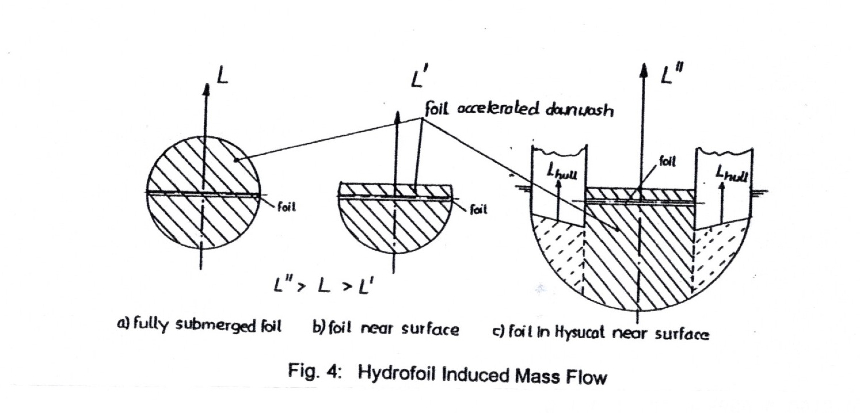
In the Hysucat arrangement the mainfoil is attached to the vertical tunnel walls and the foil has no tip vortex.
The foil induced downwash mass flow of hulls, and the foil is much larger than the downflow behind a free foil. The larger the induced downwash is, the more efficient the foil-hull combination will be.
This influence allowed the Hysucat to be considerably more efficient than originally expected.
Later we changed the name to Hysucraft (hydrofoil-supported craft) as we also developed foils for multihulls and even monohulls.
The fundamental design concept for Hysucraft was changed from “hydrofoils” in that the foils would only carry a partial load of the craft and relegate the stability reserves to the remaining portion of the hull that was in contact with the water surface.
So, there were no stability problems with our Hysucraft compared to “conventional” hydrofoils, wherein stability was a major problem. Hysucraft have none of the above design and operational constraints typical with hydrofoils. Further, the foils are smaller, lighter, and thinner – and therefore cheaper.
However, I want to mention two systems which give Hysucraft increased efficiency. The first are surface propeller systems with high OPC values. These propellers create strong uplift forces at the transom in the order of the thrust forces.
This has the effect as if the ship would be lighter which needs lower power. This uplift has to be incorporated in the trim calculations or it requires a certain LCG shift or foil shift.
The other propulsion system is a Servogear adjustable pitch propeller system which has a considerable higher OPC in the lower speed range as the pitch can be reduced for maximum propeller efficiency. This allows it to overcome the hump resistance at Froude number around 0.8 to 1.2 which is especially high when the Hysucraft is heavily loaded.
For extreme high speeds the propeller pitch is increased to deliver very high OPC values. Servogear systems also come with propeller half tunnels that create a significant uplift force, which in turn reduces apparent ship weight.
Hysucats can also be designed to land on sandy beaches and are easily transported on flatbed trailers.
Please compare now the typical hydrofoils with our Hysucraft in the below image, which shows the first 5.6-metre Hysucraft on the water as a manned half-sized sea model.
You can hardly see the small mainfoil amidships and the twin rearfoils for trim stabilisation near the transom. This little boat performed exceptionally well even in extremely rough seas.
We gained the Shell design award for it, a first for Stellenbosch University at the time.
The BMI-Hysucat was tested for a whole year in the sea around the cape and many experts and vessel crews from the navy and private shipping companies were invited. They checked out the Hysucat’s performance even in wave conditions that no deep-V-hull vessel owners would dare to run with speed. This was in the 1980s.

Many Hysucats were designed after this in South Africa first and soon after in Germany, Thailand, Australia, the USA, the UK, New Zealand, Brazil, Chile, Argentina, and Hong Kong among others. Including Hysucraft designs that are not our own, there must be several thousands of them on the water worldwide right now!

Ship evaluation method
During the Hysucraft development a tool was required to enable comparison of the ship’s efficiency with those of other craft. We already used a method to compare the quality of a foil wing with a planing craft by use of the aeronautical term lift/drag ratio.
In ship building the inverse is used to compare hull qualities, called the Resistance/Displacement ratio ε with R and D in Newtons it gives a dimensionless ratio.
The ship weight is usually given in t = 1000 kg but as a force has to be in newtons: D [N] = D [t] * g [m/s²] with g being acceleration of earth, 9.81 [m/s²]. In Fig. 19 the Resistance over Displacement Ratio ε is shown and tendency curves of various types of ships indicated, including hydrofoils and Hysucraft which give best efficiency for fast craft.
However, to compare the whole ship’s or boat’s quality their propulsion power Pb [kW] has to be compared.
Pb is in the horizontal direction, whereas D is in a vertical direction and the basic Power:
Pbasic is D [N] * Vs [m/s] = Pbasic [kw]
A dimensionless ratio is achieved by the ratio of:
Pb / Pbasic = Pb / (D [N] * Vs [m/s]) = EPS which is the equivalent to R/D ratio but by comparison of Powers.
The EPS turned out to be the inversed of the well known Transport Efficiency.
We determined the EPS ratios of many different ship and boat types and collected them and plotted them over the dimensionless ship speed, (the Froude Displacement number) in the second chart below, which also shows tendency curves of typical ship types. This gives a good idea how ships compare and for which speeds they are best suited.
We developed the hydrodynamic performance ratio (HPR) by dividing the Froude number by the EPS value, which is called HPR. The HPR indicates a ship’s quality by a single number. The largest number indicates a most efficient craft. The most efficient ships hardly reach a HPR of 30, which would be the most efficient craft seen.
The best hydrofoils reach about 22, USS Tucumcari about 18.3, some hovercraft about 26.3, SES Corsair about 22.54, the demonstrator craft Thunder Child II with 26.176 at top speed and 24.117 at 45 knots cruising speed, and the Alpha Yacht with 28.765 to name a few examples.
The above evaluation method gives every boat owner a tool to find out how well their ship compares to others.
Hydrofoils’ HPR data are somewhat disappointing as these might have been adversely influenced by the low OPC data of the propulsion system and by the often-used V-foils. It might have even impeded worldwide hydrofoil craft development. We thus see hydrofoils still used in certain countries but hardly any new developments in recent years.
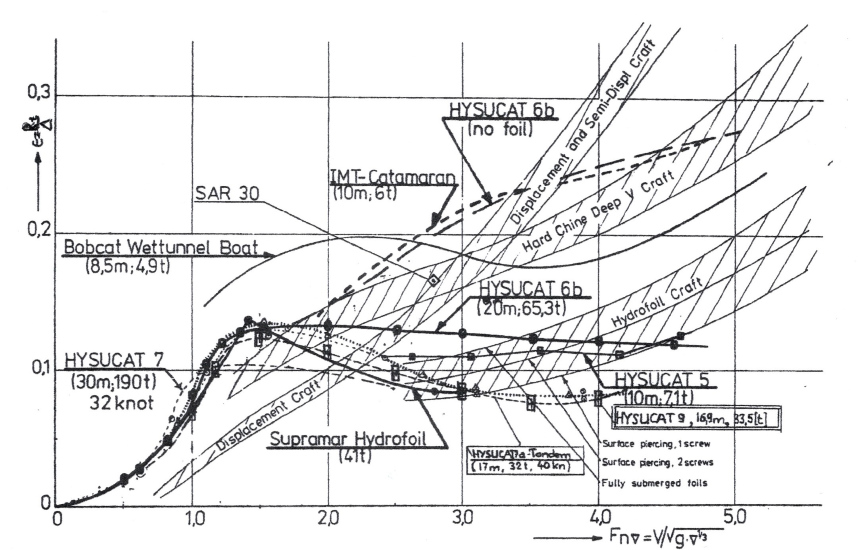
More recently a Hysucraft hydrofoil system was designed for the 23-metre trimaran Thunder Child II of Safehaven Marine in Cork, Ireland in collaboration with Frank Kowalski.The foils improved Thunder Child II ‘s performance by nearly 35 per cent.

The World Speed Record Run for boats of 15 metres length or more was then established on August 9, 2020 on the Cork-Fastnet Rock-Cork route with average speed of 45 knots and 53 knots top speed. We are proud of this considerable result together with Frank Kowalski.
I hope that my contributions to the IHS project are well understood and that it dispells the notion of hydrofoils becoming obsolete. Hydrofoils will continue to be developed, maybe just in minor deviations from the traditional hydrofoil designs as the enormous lift-drag ratio of hulls with foils cannot be ignored in marine technology overall.
Already sailing boats are revolutionised by foil assistance and many smaller boats, especially those with electric propulsion systems, are showing improved performance.
I hope that the IHS will continue their valuable efforts and present the technological development of hydrofoil wings to improve popular understanding.
More great content as part of this month’s Hydrofoil Week right here.
Related Posts
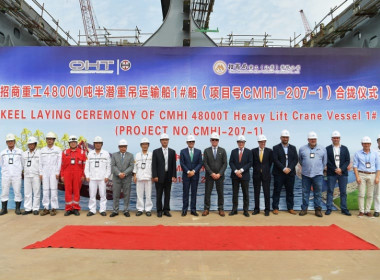
Baird Maritime
Tags: Argentina Australia Boeing Brazil Chile Germany Hong Kong hydrofoils Hysucat HYSUCRAFT International Hydrofoil Society Ireland New Zealand Nordblitz Russia Safehaven Marine South Africa South African Navy Stellenbosch University Thailand Thunder Child II United Kingdom US Navy USA USS Tucumcari
- Previous Maersk Product Tankers completes sale of 14 vessels to CDBL
- Next VESSEL REVIEW | Seven Island Yui – New hydrofoil passenger vessel enters service between Tokyo and Oshima island

Baird Maritime , launched in 1978, is one of the world's premier maritime publishing houses.
The company produces the leading maritime new portal BairdMaritime.com , home of the world famous Work Boat World, Fishing Boat World, Ship World, Ausmarine, and Commercial Mariner sub-sites, and the industry-leading ship brokerage platforms WorkBoatWorld.com and ShipWorld.com .
Contact us: [email protected]
© Copyright - Baird Maritime
- Terms & Conditions
- Advertise with Baird Maritime
- Submit News/Leads
- THE PRINCESS PASSPORT
- Email Newsletter
- Yacht Walkthroughs
- Destinations
- Electronics
- Best Marine Electronics & Technology
- Boating Safety
Sailing’s Hydrofoiling Revolution
- By Herb McCormick
- January 18, 2023
There’s a revolution underway in the sport of sailing, and it can be summed up in one simple word: foiling.
More specifically, we’re talking about hydrofoils , the winglike appendages mounted beneath the hull of a vessel that, at a certain speed, lift the hull clear of the water. When this happens, the foiling sailboats can reach speeds two or even three times faster than possible in “displacement” mode.
And sailboats are just one element of the foiling revolution: Surfboards, paddleboards and powerboats are also getting in on the act.
An Italian naval architect named Enrico Forlanini is credited with developing the first waterborne hydrofoils, which he affixed to a 60 hp, airscrew-driven craft that topped off at 36.9 knots back in 1906. In the century that followed, a series of would-be inventors took a swing at the concept with varying degrees of success. Foiling sailboats finally ascended into the mainstream during the 2013 America’s Cup, when Oracle Team USA beat Emirates Team New Zealand in a match between foiling 72-foot catamarans (the Cup has been contested in foiling cats ever since).
Surprisingly enough, my first foiling experience happened some three decades ago, aboard something called a Hobie TriFoiler, from the popular manufacturer of Hobie surfboards, beach cats and kayaks. The TriFoiler, basically a 22-foot trimaran with a central pod and a pair of mainsails stepped on the twin outriggers, was invented by a fanatical California engineer named Greg Ketterman. The sail controls were laid out just forward of the tiny airplane-style cockpit; you steered with foot pedals. It was so ridiculously easy that even a gremmie like me had the thing foiling within moments of getting in and reaching off.
But after the initial thrill, it was actually kind of boring. Which, I believe, is why it went out of production soon after. The TriFoiler was, unfortunately, way ahead of its time.
Such was the extent of my personal foiling experience until this past summer, when a new class of foiling monohull skiffs called Persico 69Fs rolled into my home waters for a series of races among youth squads in the class’s inaugural season. I got an invitation to take a spin.
After donning my helmet, wetsuit and life jacket, I was handed the helm with a pair of skilled young sailors on board. At 25 knots, we were towed into Narragansett Bay behind a powerful RIB, foiling all the way. It was terrifying. And a preview of coming attractions.
Once the tow dropped us, the sails went up and we bore off. I skied the tiller extension while scrambling out onto the hiking racks. Which sent us off on a screaming reach. Which flipped the 22-foot-7-inch carbon rocket ship.
Twenty seconds into foiling, and I’d capsized the bloody thing. How embarrassing.
The kids, bless them, were kind and patient. We got the whole shooting match, including ourselves, back upright and tried again. The mainsail trimmer sheeted it home, we started to accelerate, and he said: “Here we go! You’re up. You’re flying!” Indeed, we were.
Hard on the breeze in the 12-knot southwesterly, things unfolded quickly. Spray was flying, and I took more than one solid wave to the kisser. I was mostly too frightened to concentrate on anything but driving, but I did glance at the speedo once: 17.4 knots. (I felt pretty chuffed until later learning a 69F’s top speed is 34 knots. Ugh.)
However, I guess I’d proved the point: With a couple of sailors who know what they’re doing, foiling is for everyone. From now on, just call me Mr. Foiler.
- More: Foils , Hydrofoil Boats , Hydrofoiler , November 2022 , Sailboats , Sailing Yachts , Yachts
- More Yachts
Tankoa Introduces 230-Foot Milano
New flagship for bering yachts: the b165, power catamaran popularity rising, “energy observer” zero-emission boat showcases sustainability, for sale: 127-foot burger motoryacht, new to the yacht charter fleet, for sale: princess yachts f55.
- Digital Edition
- Customer Service
- Privacy Policy
- Email Newsletters
- Cruising World
- Sailing World
- Salt Water Sportsman
- Sport Fishing
- Wakeboarding
Home » Homebuilt Hydrofoil for Sailboats test sailed – end to hiking out?
Homebuilt Hydrofoil for Sailboats test sailed – end to hiking out?
Launching our Homebuilt Foil stabilised dinghy – this article is to use our experiment as the basis for low cost foiling that anyone can use to build or modify a boat – it sailed nicely in 5 to 10 knots and I didn’t have to do any hiking.
This is not about outright speed (wrong hull type for a start). It is about stability without hiking out. On the other hand if it works on this boat … it will work on anything!
No worthwhile video I am afraid – little wind when the photo boat was available on Sunday. We will get some next weekend with luck.
This is part of a four article set
- Part 1 – Sailing Trials in 5 to 10 knots of the hydrofoil stabilised dinghy.
- Part 2 – Building a Hydrofoil Stabilised dinghy – and proposal for comparison using any hull. Up later today
- Part 3 – Video in more wind – Next weekend if there is wind!
- Part 4 – Three Homebuilt hydrofoiling Projects – democratising foiling! Up Next week
Myth busting Foiling Boats – you don’t need a factory and you don’t need carbon fibre.
Everyone knew this once – because the recent history of making foiling work was achieved with homemade foils using timber and fibreglass.
The great Myth about foiling boats is “that it is high tech and everything has to be carbon”. But all the significant development in the Moth Class was with wooden hydrofoils that were fibreglassed with only small amounts of carbon or stainless steel.
The specification itself is to provide a basis for cheap experimentation and comparisons of performance.
The Foiling Moths advanced so quickly because there was a specification and people messed around with the spec and shared information. Wood and glass make fast modifications to homebuilt hydrofoils easier (and cheaper)
Maybe even racing if anyone has a mind to. But also as the basis of comparison with boats in other areas.
What does it feel like – a homemade foil stabilised boat upwind
We had good luck for the first day of testing – 5 to 10 knots and a well sailed Oz Goose as a pace boat. Started to get a feeling of the speed potential.
This section is about that.
Second day when we had a chase boat with cameras – of course the wind died. Hopefully we will have video next weekend.
The lateral foil to leeward needs to be kept in the water in the lulls. In 5 to 10 knots this meant sitting a little to leeward.
Initially as gusts hit I would follow instinct and make the wrong move. Hiking out brings the foil would to near the surface, would ventilate (suck air from the surface) and then the boat heel and slow.
Well … it is obvious … sit to leeward in the lulls, when the gust comes let the foil do the work – don’t move out to windward.
No Hiking. But with the same sail they were hiking in the accompanying Oz Goose .
So what to do when a boat with a lateral foil heels?
Don’t move your butt! Ease the sail and point a fraction lower to get the boatspeed up. The lateral foil starts to rise because of more lift – fly it up again.
Then I could wind in the sheet again to increase the heeling force. It is a feeling like flying. Boat heels then get speed without increasing the heeling force. Wind drops, move your body a little to leeward. Sheet loads seem higher – greater stability than hiking?
It becomes quite mesmerising watching the foil a foot or two below the water surface.
As the foil produces lift there is a depression in the surface of the water above the foil – which turns into a series of waves that make up the foil wake stretching back. It it like being followed by a small Loch Ness Monster.
It does also show that the homemade hydrofoil is developing lift at low speed.
The photo is at a very low windspeed/boatspeed. These wavelets go quite a way back. On Saturday with more wind and boatspeed I thought the transom was digging in and making a commotion.
But, it was the combination of the hull’s sternwave and the foil’s wake making a noisy quarter wave on the leeward side
So this is the exciting thing – not pure speed but less physical effort
At the moment many foiling systems are more or less being retrofitted to conventional boats.
Many of those boats are very wide – like the IMOCA 60s or some of the supermaxis.
Interestingly it is more moderate beam boats that win most races. They are faster in light winds, faster upwind and can sail deeper angles downwind without losing speed. A bit easier to steer too.
The question is … if we gain stability from a lateral hydrofoil – what is the beam for?
Canoes are light, fast and easy to store and transport. But can be hard to hold upright. PERHAPS this is a good place to start.
Another aspect is that modest length boats for disabled sailors have limited stability (and speed) because the centre of gravity of the crew is so high.
I also think about what will happen when I can’t hike out so hard. That’s why I win Oz Goose races. But I can certainly feel it in my 60 year old bones. The day is not close, but it is coming.
The inspiration of the Quant 28 and 17
Normally a keelboat this size without a canting keel would need 5 to 7 people on the rail.
Same lateral foil but a more beautiful version by Hugh Welbourne for Quant Boats in Switzerland.
The lateral foil is the simplest possible lifting foil.
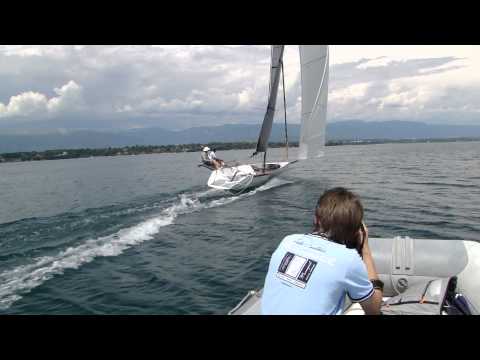
In terms of stability – see how the crew on the Quant 17 go from full trapezing and hiking to sitting inside the boat when the foils are deployed and to leeward as soon as the boat has any downwind component.
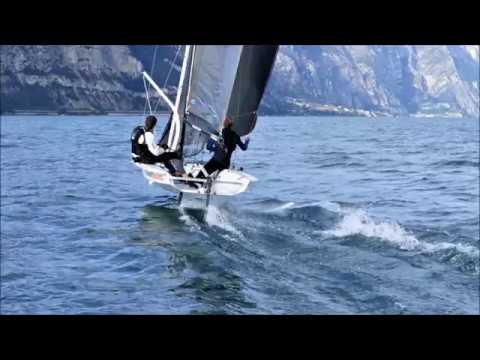
I’m interested in the stability component.
In homebuilt hydrofoil boats Ian Henehan’s modified Oz Goose saw him chuck the hiking wings and start sitting inboard too.

It was like this with a hiking rack before – no longer needed. Simplification and less effort.

Perhaps: an advantage of some rocker for foiling dinghies
We didn’t fit a rudder foil at this stage – even though we built the rudder extension.
The purpose of a rudder foil on all foilers is to hold the main foil at an optimum angle of attack. Usually the rudder foil is adjustable in some way to allow the adjustment of the angle of the main foil.
If the rudder foil is sent lower then the angle of attack of the main foil is increased.
But with the 8ft boat with the extreme rocker it was possible to move back to increase the angle of incidence of the main foil. The base angle is 2 degrees Angle of Attack relative to the static waterline of the boat.
In the gusts of around 10 knots, going upwind, it was possible to move forward or back to reduce or increase lift – speed changes from doing so were instant. So where you sit in/on a rockered boat is a critical tuning factor.
Less rocker might be OK, but some rocker is going to be important. Maybe concentrated in the back end of the boat. I’m not sure if the foil fitted IMOCAs do this with water ballast.
Overview of comparison sailing the hydrofoiled boat against the larger Oz Goose
This is not necessarily a question of speed, though it is nice to get.
Our 8ft boat is absolutely sub optimal as a foil stabilised boat.
- It is short, so potential hull speed is low – 8ft long. This limits foil lift (square of velocity).
- It has a lot of rocker (fore and aft hull curve)
- Crew weight is a very large part compared to the boat volume – it was meant to be a prototype kid’s boat but the curved cockpit was too hard to build. So we repurposed it.
Saturday it was sailing around in company with Job and Jazmine in a Goose who I compete against in that class. They are among the top sailors in the Oz Goose so I know the speeds they hit. And the new boat has an Oz Goose Rig but is only 8ft to the Oz Goose’s 12ft length.
In the lighter patches it was noticeably slower than the Goose, but it was still sailing properly (felt normal/good). It was a faster choice to retract the foil. Pushed out to windward the hydrofoil is above the water to reduce the wetted surface.
With a bit more wind and foil deployed it started to equal the goose upwind. This is not something the shorter boat should be able to do.
The biggest difference – no hiking. While Job and Jazmine were hiking in the Oz Goose I found it best to move to keep the foil in the water in the lulls – which meant I was sitting centrally or to leeward and not hiking in the gusts. It is low effort sailing.
Downwind differences – was the 8ft foiled boat able to stick with the 12ft Oz Goose?
Downwind the Goose should have walked away from the smaller boat. I’ve a lot of experience with the 8ft Oz Racer and a GPS and know the boat tops out at around 4.2knots or just about 5. It can go quite a bit faster (up to 8knots) but it takes a lot of wind and it drops back to the 4 to 5kn range as soon as the gust drops slightly. The Goose, however just loves to accelerate into the 6 7 or 8 knot range and on stronger wind days gets up in the 8 to 12 knot range. And beyond.
So the Goose should get away from the shorter boat.
It did … but not too dramatically. More comparative trials to come.
Now we hope there is more wind next Saturday when we have the photographer and a chase boat.
Foiling Week 2018 Pt 2 – Foiling Sail for the rest of us!
Our recent articles on homemade foiling and
2 thoughts on “homebuilt hydrofoil for sailboats test sailed – end to hiking out”.
We just post an abstract of your pages about foils in our web site. Thanks for your job. Best regards Danilus
Merci Daniel!
Can you provide a link here to the article on your website.
Also we hope to get more wind to show how the foil behaves. We had one day of moderate wind but no photo/video boat. But last three weekends have had very light wind – sub 5kn. A more active video when Poseidon grants our wish.
Best wishes Michael
Leave a Comment Cancel reply
This site uses Akismet to reduce spam. Learn how your comment data is processed .

300 Whale Tail Hydrofoil Stabilizer

200 Whale Tail Hydrofoil Stabilizer

Dorsal Fin Style Hydrofoil Stabilizer
- Quality Statement
- Shipping Options
- Installation Guide
- Technical Manual
Boat Hydrofoil Pros and Cons: Is It Worth the Investment?
If you’re a boat owner, you’ve likely heard about boat hydrofoils and the potential benefits they can bring to your boating experience. But are they worth the investment? This comprehensive guide will explore the pros and cons of outboard hydrofoils, providing you with the necessary information to make an informed decision.
Understanding Hydrofoils
A hydrofoil is a specialized device designed to create lift when moved through water, similar to how an airfoil works in the air. The unique shape of the hydrofoil allows water to flow faster over it than underneath it, creating a low-pressure area on top. This pressure https://guardmarine.com/product/dorsal-fin-style-hydrofoil-stabilizer/ difference generates lift, raising the boat’s hull above the water and significantly reducing drag.

The Science Behind Hydrofoils
In simple terms, a hydrofoil works by manipulating the flow of water around it. As the boat moves forward, water flows over the hydrofoil, creating a pressure difference that lifts the boat. This reduces the amount of hull in contact with the water, thereby reducing drag and allowing the boat to move faster and more efficiently.
The Pros of Boat Hydrofoils
There are several benefits to installing a hydrofoil on your boat, including:
Enhanced Boat Performance and Speed
The primary advantage of hydrofoils is their ability to improve a boat’s performance. By reducing water resistance, hydrofoils allow your boat to move faster. This effect is particularly noticeable on smaller boats with outboard motors, such as fishing or leisure boats.
Improved Fuel Efficiency
Hydrofoils can also enhance your boat’s fuel efficiency. By reducing drag, your boat’s engine doesn’t have to work as hard, leading to less fuel consumption. This means you can enjoy longer trips without worrying about refueling.
Increased Stability
Hydrofoils can significantly improve your boat’s stability, providing a smoother ride even in rough waters. This is due to the balance and stabilization that hydrofoils provide, even at high speeds.

Enhanced Safety
Hydrofoils can also enhance safety by eliminating issues like low bow rise, cavitation, porpoising, prop ventilation, and chine-walking.
The Cons of Boat Hydrofoils
Despite their numerous benefits, hydrofoils do have some limitations:
Limitations for Large Boats
Hydrofoils are not recommended for large boats or ships as the benefits won’t be as significant.
Prone to Damage
Hydrofoils are prone to damage from repeated impacts, which could lead to steering issues or accidents.
Frequently Asked Questions
Does boat size matter when purchasing a hydrofoil.
Yes, boat size does matter. While some hydrofoils are suitable for larger boats, most are best suited for small to mid-sized boats.
Can Bumps Damage a Hydrofoil or Cause it to Fall Off?
While hydrofoils are made from durable materials, a significant impact, such as hitting a rock, could cause the hydrofoil to fall off.
In conclusion, the benefits of installing a hydrofoil on your boat include improved speed, efficiency, and stability. However, it’s important to consider their limitations before making a purchase. By understanding the outboard hydrofoil pros and cons, you can make an informed decision that best suits your boating needs.
Related Post

Common Misconceptions About Hydrofoils for Outboard
- 7月 15, 2023
- Category: Hydrofoil Stabilizers

Hydrofoil Stabilizers: Revolutionizing Marine Speed and Efficiency
- Category: Hydrofoil Stabilizers , Related Topic

What Is a Hydrofoil for an Outboard?
- 7月 26, 2023
Contact Us Today, Get Reply Tomorrow
Your information will be kept strictly confidential.

I am Evelyn, the sales service manager of Guard Marine, me and my team would be happy to meet you and learn all about your business, requirements and expectations.

Home » Blog » Sail » Hydrofoil boats for the rest of us
Hydrofoil boats for the rest of us
By Author Fiona McGlynn
Posted on Last updated: August 18, 2023
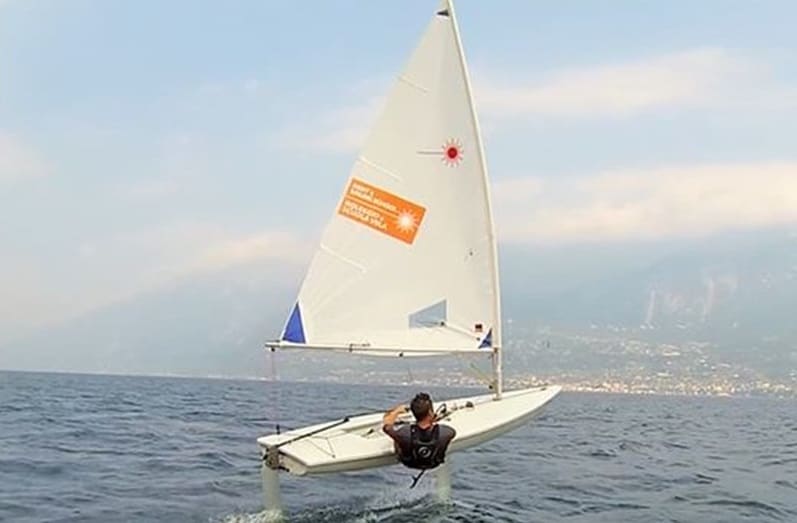
Glide Free Foils Laser on foils. Photo credit: sailboats.co.uk ,
Watching foiling boats fly around the America’s Cup race course, is enough to quicken any sailor’s pulse. But unless you’ve got a spare few million kicking around, most hydrofoil boats are still very much out of the average boater’s budget . There are however a few ways to experience the magic of foiling without racing towards bankruptcy.
HOW DOES HYDROFOILING WORK?
Much in the same way that air flows over and under aircraft wings to create lift, water flowing around a hydrofoil lifts a boat’s hull out of the water . Once the greater part of the boat’s surface area is out of the water, friction is greatly reduced and the boat can “fly” at faster speeds .
How fast? The 2021 America’s Cup AC75s are expected to reach top speeds of 40 to 50 knots!
Like sails, foils are not a matter of “set it and forget it”, instead the foil-attitude must be adjusted to keep the boat in flight . On the 2017 America’s Cup boats these adjustments were made by the skipper/helmsman but powered (via a hydraulic system) by crew grinding winches (or in New Zealand’s case, pedal bikes ).
Because we don’t all have Jimmy Spithill ‘s magic touch, developing highly sophisticated flight control systems is key to bringing foiling into mainstream boating. Candela, a new 25-foot production e-foiling powerboat (and 2019 Best of Boats award winner) offers such a solution with foils that change position 100 times per second! Still, at ~$240,000 it’s well beyond most boating budgets.
Fortunately, smaller foilers (dinghies and boards) don’t require high tech flight control systems and are far less expensive . Here are a few options for (more) affordable foiling:
HYDROFOIL DINGHIES
Laser foiling kits.
Clip a foil onto your Laser and fly over the surface of the water. Two Australian based companies, Foilsz and Glide Free Foils , offer Laser foiling kits. The Glide Free kit doesn’t require any permanent fixtures, so you can easily remove it (for those days when you’re in a displacement mode mood). They say that speeds of 18-25 knots are possible with their kit, which sells for just under $4,530 AUD (~$3,00 USD).
UFO foiling multihull
For a few bucks more you can buy a foiling catamaran. The UFO was launched in 2017 and can fly at 15-20 knots. With a price tag of $7,000, it may be the most economical multihull foiler on the market.
Take a foiling course
Some clubs and community sailing programs are adding foilers to their fleets. For example Nantucket Community Sailing offers a 3-hour semi-private class for $100 per person . Or if you’re looking for a more exotic locale, the Provela Foiling Centre in Spain offers a range of foiling classes from beginner to advanced. Their two-day “Try Fly – Foiling” class costs 200 euros and their fleet includes Foiling Moths, White Formula Whispers, WASPZs, and F101s.
HYDROFOIL KITEBOARDS
It’s not like kiteboards are sluggish to begin with, but hydrofoil boards take the sport to a whole new level, delivering speeds of 40 miles an hour ! By using a foil to lift their boards out of the water, foiling kiteboard enthusiasts get an exceptionally quiet and smooth ride – so much so, that kiteboard riders in Silicon Valley have been spotted taking calls on their cell phones. Set up costs start at around $1,000. Take a foil boarding course and buy protective gear, this extreme water sport is not for the faint of heart.
HYDROFOIL WINDSURF BOARDS
Foiling is taking off in the windsurfing world with world champions like Robby Naish and Atoine Albeau leading the charge. It has been confirmed that windfoiling will be a class at the 2024 Olympics in Paris . Set up costs start around $2,500.
With foiling technology trickling down into the mainstream, you can expect to see more and more high speed foiling boats and boards on the water . Is foiling the future? Let us know what you think in the comments below.
Fiona McGlynn is an award-winning boating writer who created Waterborne as a place to learn about living aboard and traveling the world by sailboat. She has written for boating magazines including BoatUS, SAIL, Cruising World, and Good Old Boat. She’s also a contributing editor at Good Old Boat and BoatUS Magazine. In 2017, Fiona and her husband completed a 3-year, 13,000-mile voyage from Vancouver to Mexico to Australia on their 35-foot sailboat.
Terms and Conditions - Privacy Policy

Does A Hydrofoil Really Work? (Explained For Beginners)
Your boat’s speed and lift will affect how it cuts through the water.
Many boats use hydrofoils to get the best speed and reduce drag.
But do they really work?
Here’s How a Hydrofoil Really Works:
A hydrofoil is a surface mounted beneath the boat. As a boat picks up speed, this surface generates lift and begins to rise, eventually raising the boat clear of the water. With the hull above the water’s surface and no longer causing drag, the boat’s speed greatly increases. If the boat maintains speed, it can ride up on the foils indefinitely.
Table of Contents

What Exactly is a Hydrofoil?
A hydrofoil is a surface, usually a wing-like structure, that provides lift in the water.
They operate in the same manner as airfoils do on airplanes. This structure is mounted under the hull of a boat with struts or on the bottom of the centerboards on catamarans.
As the boat picks up speed, these foils lift the boat, and the hull is raised out of the water.
The foil moving through the water creates higher pressure on the bottom of the foil and reduced pressure on top; this is how the lift is generated. This lift continues to raise the boat until a balance exists between the lifting force and the craft’s weight, and a point of equilibrium is reached.
When a boat is foiling, the entire wetted surface of the hull is eliminated and no longer causes drag. The only surface causing drag are the foils with their much-reduced surface area.
This propels the boat too far greater speeds than could ever be reached with its hull in the water. This is because the sails generate the same power, but the hull’s drag is no longer working against it.
The hydrofoil can actually take several different shapes. It might be a simple wing-like surface, or it may resemble a bent arm. Some have flaps that are controlled remotely.
Some hydrofoils, particularly some of the earlier models, are designed to lift the bow of the boat clear out of the water rather than the entire hull.
There is a point of speed approaching 70 miles per hour where the acceleration levels off. This is due to cavitation on the foil, which bends the foil’s surface and keeps it from going faster. First identified in the 1950s, even modern hydrofoils struggle with this phenomenon.
Another problem with hydrofoils manifests if they are operating in waves. If the foil cuts through a wave’s surface and passes through the air, the lift is negated, and a negative attack angle is generated.
This causes the boat to crash back down when the foil hits the next wave.
Hydrofoils are also susceptible to being damaged. They are thin, and striking an object in the water can damage the foil or the attachment point on the hull.
What Types of Boats Can Use Hydrofoil Technology?
There are a variety of boats that can use foiling technology, both sailboats, and motorboats.
In most of these cases, the boat is designed to have the foil rather than adding the feature at a later date.
Hydrofoils are also generally expensive to develop and produce, so their use is not widespread.
The technology was developed originally in powerboats, both as a test of the concept and to push for greater speeds and records.
The militaries of various countries have used hydrofoils. The US navy developed several models, particularly the Pegasus class, but these were discontinued in the mid-1990s because they were not deemed cost-effective. Russia’s military has continued to use and develop hydrofoil technology, particularly in patrol or torpedo boats.
Several passenger boats, like high-speed ferries, have been built to use hydrofoils. These are expensive to produce and maintain, so they have generally appealed to a more wealthy clientele. These kinds of ferries are on the decline worldwide, though they are still in heavy service in Japan and parts of Asia and Europe.
Some of the most visual examples in the sailing community are the past several America’s Cup boats.
The previous two challenges used foiling catamarans, while the 2021 series uses a foiling monohull with a rotating wing.
Some lightweight, small dinghies have been successfully retrofitted with foiling technology, such as some Moth-class boats.
Various racing boats have been developed to use foils, both monohulls, and catamarans, from dinghies all the way up to 60-foot offshore yachts.
There are some surfboards and kayaks that are designed with hydrofoils. Some kite-sailing boards are using foiling technology. Many windsurfers have adopted foiling technology.
There are also new kinds of electronic personal watercraft being developed and sold. These are essentially platforms or skis that a rider stands on, and as speed is gained, it rises on the foil and carries the rider several feet above the water.
However, they are not designed for speed, just the experience of foiling and have a top speed of about 25 mph.
How Much Does it Cost to Have it Added?
Most hydrofoiling boats are built around the foiling concept rather than having it retrofitted.
There are exceptions, like the foiling moths. New foiling moths cost from $10,000 to $20,000.
Some moth sailors on forums who have added hydrofoils to their hulls say they spent as little as $1,000 on materials, but $5,000 seems to be the average cost based on the most recent posts by the more serious racers.
There are foiling kits that may be added to other boats, as well. A hydrofoiling kit to add to Lasers, made by the company FOILSZ, costs around $2,700 in the USA.
Adding a foil to an existing keelboat has not been done. The cost of retrofitting an existing is theoretically prohibitive, and these boats are almost all cumbersome compared to the boats designed to foil. It is cheaper (though still costly) to buy a monohull designed for foiling, given the cost and uncertainty.
Likewise, most foiling catamarans have been designed and built around the concept rather than being retrofitted. But there are some exceptions, like the A-Class catamaran. Many owners who race have installed their own foils, with a starting price of around $3,000 in most cases.
Other boats, like the Hobie 16 and Prindle 19, have seen models retrofitted with foils. Several companies make foils for this purpose.
HydroSail is one such manufacturer. Their smallest foiling kit costs#1,000 and is suitable for a Hobie 16. The next size up is suitable for a boat around the Prindle 19 and costs $5,000.
They also make a kit for much larger catamarans, and it costs $30,000.
Adding foils to a windsurfer will cost around $2,500 as an initial cost, though better foils cost more than this. Putting foils on a surfboard starts at about $1,200.
As with sailboats, most powerboats with foiling technology were designed and built to the concept, rather than having them retrofitted on the hull. This is because of the extensive rebuilding that would need to be done in beefing up the areas of foil attachment and the hull design being different and not necessarily conducive to hydrofoiling.
Some of the first retrofitted kits for small powerboats were called the Up-Right Hydrofoil Kits, built between the years 1961 and 1962 by the Up-Right scaffold company.
They did not sell enough to make a profit, though, and the product was discontinued. Since then, few retrofitted hydrofoil kits were made for powerboats, and none of them have been particularly successful.
Some hydrofoils attach to the bottom of outboard motors. These do not lift the boat out of the water as conventional hydrofoils do; instead, they are intended to stabilize the ride and help fuel efficiency.
Claims of increased speed are made, but most do not feel they actually make the boat faster. These are commonly listed for around $1,000.
How Stable and Safe is a Boat Using Hydrofoil?
Stability is a concern for hydrofoiling boats, as they become more top-heavy when they are riding upon the foils.
Observation of America’s Cup catamarans will reveal a bit of porpoising on the foils as they rock slightly back and forth while raised out of the water.
A hydrofoiling boat has a motion that is closer to a plane than a conventional boat. It has to contend with six ranges of motion, specifically surge, sway, roll, heave, pitch, and yaw. It can be difficult to control all of these, though electronic trim tabs on larger boats help.
As long as a foiling boat maintains its speed, it is a relatively stable platform. As mentioned earlier, coming out of a wave will make the boat dive and land hard back into the water.
As far as safety goes, foiling can be dangerous. Experienced mariners will handle one without much difficulty, but a beginner will not feel comfortable initially riding on the foils. The danger here is not great, though, as it simply means getting off the foils and getting the hull wet again.
There is a danger with foiling surfboards, however, if there are other surfers about.
A fast-moving foil that strikes a fellow surfer can hurt them very badly.
Is a Hydrofoil Really Worth It?
If you want to experience the fastest a sailboat can go, the answer is yes.
It will be an expensive proposition, but there is little comparison to the rush of flying above the water.
For the commercial hydrofoiling powerboats like ferries, the answer is proving to be no, as the boats and their maintenance are far greater than a standard, similar-sized boat. While there are still commercial hydrofoiling ventures in existence, they cater to smaller, increasingly wealthy clienteles, and they are finding it difficult to maintain profitability.
The expense and upkeep will probably not justify buying a boat with hydrofoils for the casual sailor or powerboater.
Hydrofoil – Wikipedia
How a Hydrofoil Works – MIT
Hydrofoils: Expert Advice – Boat US
HydroSail Home
Hydrofoil Control
Click to share...
Hydrofoil Sailing
Boats That Fly
Site Navigation [Skip]
- Latest Updates
Sailboats have been using hydrofoils to fly above the water for over 50 years. However, with the advances in materials and construction, hydrofoil sailing is becoming more common. The plan for this site are to have information on many prior hydrofoil boats as well as current and future boats. There will also be other sections on upcoming events, designs and speed records.
Last update: February 2008
- Shopping Cart 0
Boat Hydrofoils Keep Your Stern Raised for a Smoother Ride and Better Acceleration
What a Hydrofoil is and Why You Need One
If you’re not familiar with what a boat hydrofoil is, let us explain. Created for boats up to 25 feet long, a hydrofoil is essentially a curved wing for the water that’s mounted to an outboard engine’s small “cavitation” plate. Similar to an airplane wing, a hydrofoil directs water flowing out from the propeller downward. As a result, the hydrofoil and entire rear of the boat (stern) are pushed in the opposite direction upward.
By extending the boat engine’s built-in cavitation plate with a hydrofoil, the chances of the propeller drawing in air and creating an air cavity are greatly reduced. Air pockets around a propeller can cause an engine to rev to high rpms while the boat struggles to go anywhere. Hydrofoils capture the water pressure that would normally escape to the top and the sides, holding more of it in close proximity to the propeller. Not only are air pockets eliminated, this pressure also creates a more powerful level of forward thrust.
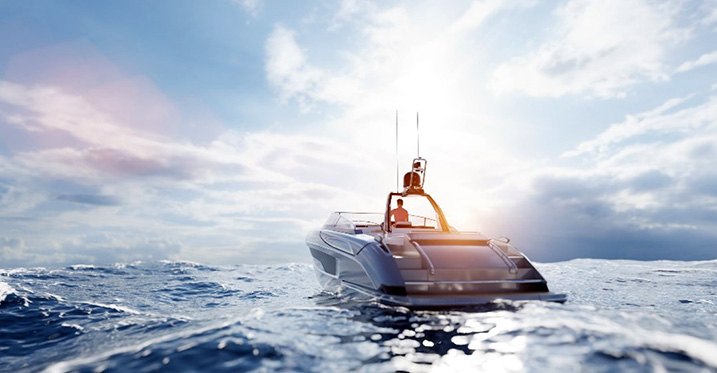
Once the stern area is pushed higher up onto the water in this fashion, the entire boat remains level under throttle instead of bogging down in the rear and rising too far up in the front (bow). This is known as “getting the boat up on the plane”, where the boat appears to be gliding on top of the water at speed. The reduction of drag that occurs on plane leads to even quicker and more efficient performance in the water – saving time, fuel, and engine wear. For situations where an engine is underpowered for the size or weight of the boat, hydrofoils have been shown to deliver noticeable improvements in performance.

In addition, a level boat does not suffer the same degree of pronounced bouncing over waves that occurs when the bow area is raised too far upward. Any time the boat is in motion, a hydrofoil will yield a ride that’s smoother, less jarring, and more stable – especially as speeds increase and waves become larger. You and everyone aboard will physically feel better and continue to enjoy the boating experience much longer, reducing unwanted “drop me back off at the dock early” requests.

When it comes to watersports activities, hydrofoils add to the quality of life as well. Experienced waterskiers will be happier with your boat’s faster out-of-the-hole responsiveness, and you can maintain lower planing speeds without constant throttle adjustments if you’re towing beginning skiers, wakeboarders, or anyone in a tube.
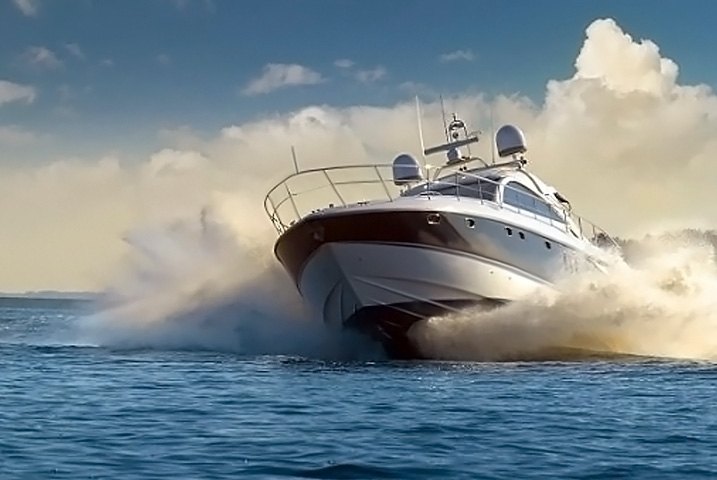
In short, this inexpensive, easy-to-install, and mechanically simple part known as a hydrofoil allows you to operate and maneuver your boat like an experienced pro. And, for pennies on the dollar, you’ll get performance and efficiency gains without making a single engine modification.
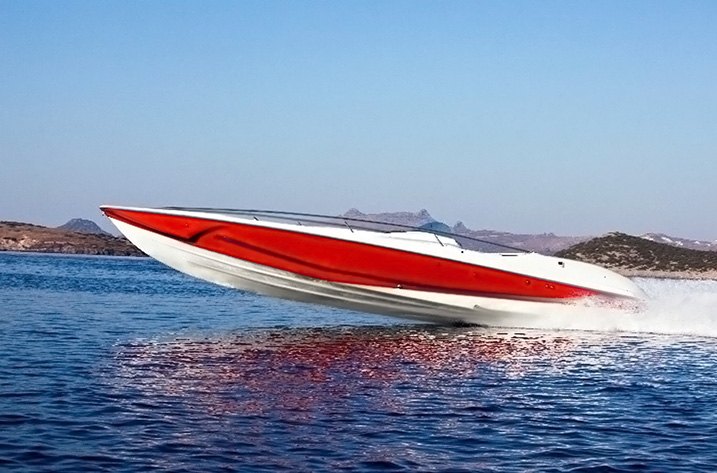
Another common issue hydrofoils correct is “chine walking” which can occur on performance boats at higher speeds. If the bow is angled upward excessively, the boat’s hull can lift off the surface of the water to the point where the contact patch is minimized too much. Balancing the hull straight on its keel becomes difficult, and much more steering corrections are required to prevent the boat from bouncing left to right continuously. With the stern pushed upward, the front is lowered and the hull maintains proper contact with the water.
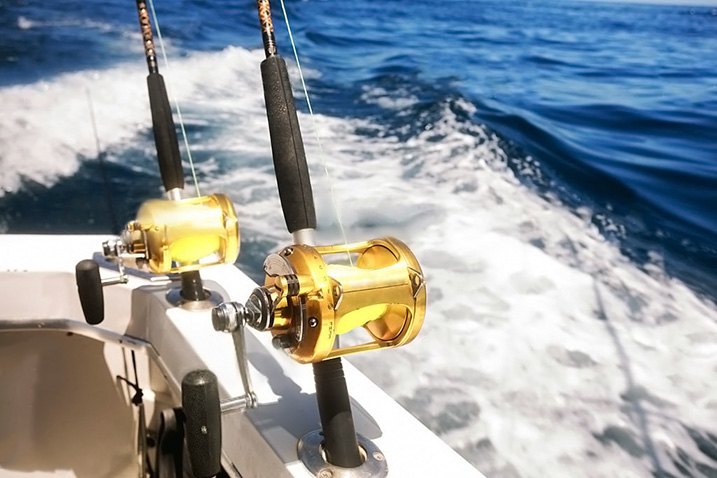
If you’ve got a deep V boat where a larger portion of the stern sits deeper than the bow, slow speed wander (or “deep V wander”) can occur when water rushing along the sides of the vessel collapses into the hole behind it. Swirling vortices create suction on each side of the transom that ends up pulling the boat rearward and to the left.
Let’s take a look at the hydrofoils we recommend.
Trolling Plates for Small Electric Motors

We’ll start with trolling plates designed for slow-speed electric trolling motors. These feature an adjustable flap designed to reduce trolling speed down to a desired 1 mph crawl when it’s in the down position in front of the propeller, then act like a traditional ride stabilizer once it’s in the up position. Choose the Davis Instruments stainless steel Happy Troller Trolling Plate or the Ironwood Pacific stainless steel Easytroller Stainless Steel Trolling Plate if you prefer manual control of the flap. The T&L hardened nylon Trol-A-Matic Trolling Plate features a flap that swings up automatically as speeds increase.
2-Piece Hydrofoils for Small Boats & Engines
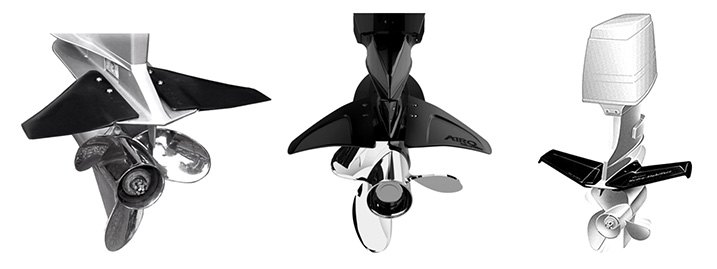
When it comes to best values for smaller boats such as inflatables, jon boats, and other lightweight craft, we’ve got 2-piece hydrofoils including the Davis Instruments Doel-Fin Hydrofoil , Attwood Hydrofoil , Sea Sense Hydrofoil , Stingray Hydrofoils AIRO Hydrofoil , and T-H Marine Hydro-Tail Hydrofoil . These are typically flat all the way across and shaped like the wings of a fighter jet. However, we’ll note that the Stingray Hydrofoils AIRO Hydrofoil does feature pronounced curvature for better lift on heavier small boats.
1-Piece Hydrofoils for Medium-Sized Outboard Engines

Compared to two-piece hydrofoils, single-piece ones deliver stronger performance thanks to greater surface area that results from overhang extending out past the propeller. The Stingray Hydrofoils Hydrofoil represents a best value pick in size choices of “junior” for small engines up to 40 horsepower and “senior” for bigger motors up to 300 hp.

We also offer SE Sport’s 200 Series Hydrofoil and 300 Series Hydrofoil which can be bolted in place or attached to the cavitation plate with an optional clip instead. (We’ll note that if you’re travelling at higher speeds and/or in rough water, you may prefer to secure your hydrofoil with screws instead of clips). For those that prefer lightweight construction, the Davis Instruments Whale Tail Hydrofoil is crafted from high grade aluminum and features an overall shape that curves down at the sides for better performance.
Hydrofoils for Maximum Lift
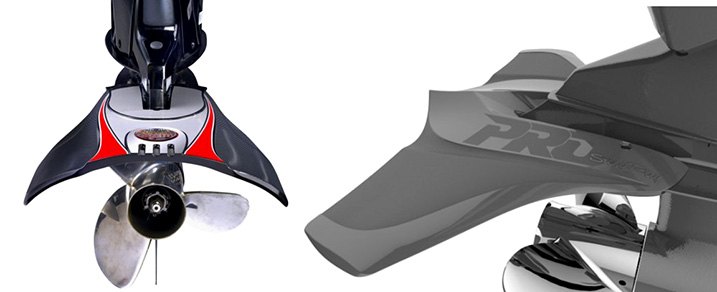
The Stingray Hydrofoils Classic Pro Hydrofoil features larger wings for maximum lift and stabilization on big engines with powerful thrust. Stingray’s XRIII Hydrofoil features a high degree of curvature across the entire width of its wings in order to pack water more tightly around the propeller and cavitation plate. This creates great lift, and it’s also recommended for the pontoon boat owner who’d like to make sharper turns without throttling down. The SE Sport 400 Series Hydrofoil features a crescent-shaped surface designed to direct water for better handling and thrust-cutting at speed.

The Stingray Hydrofoils Hyperfoil 500 Red also features a higher degree of wing curvature. Designed for the professional bass boater who needs to reach top speed quickly in order to get to schools of fish as soon as they’re detected, this is an excellent choice for powerful speedboats. Additionally, Stingray recommends their Stinger Hydrofoil for significant lift on smaller boats and engine setups while providing larger boat and engine setups with improved launches and maximum top-end speed.
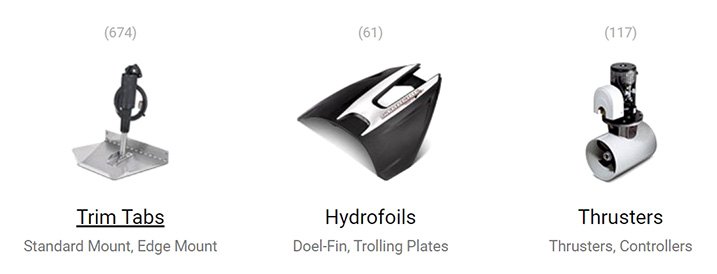
In addition to the hydrofoils covered here, we also offer a selection of trim tabs and powerful compact directional thrusters - along with a full array of hardware and components related to each.
And when it comes to everything else, we’ve also got the boating items you want and need such as electronics and navigation equipment , must-haves for interior cabin & galley areas , items for on-deck , replacement engine parts and hardware , plumbing-related items , maintenance , and other upgrades to make the boating experience more enjoyable. Whatever you’re looking for, we’re confident you’ll find the right products on the digital shelves of our online store. Visit us at www.BOATiD.com for all your marine needs, or contact our knowledgeable specialists at 888-453-5144.

- Subscribe Now
- Digital Editions

Best hydrofoil boats: 6 of the most spectacular foiling motorboats money can buy
- Electric boats
- Top stories
Foiling technology has really taken off in the past few years. We pick out 6 of the best hydrofoil boats you can buy right now…
With its roots in the 19th century, foiling technology is as old as the hills, but in the past five years we’ve noticed an explosion of hydrofoil boats coming onto the market.
In part inspired by the foiling raceboats of the America’s Cup , the popularity of foiling is easy to understand – fuel efficiency gains are substantial, noise is almost eliminated (particularly if your foiling boat also happens to be an electric boat ) and they look as cool as a snowman in a freezer!
To help you understand the dizzying array of foiling boats available right now, we’ve put together the following guide to what we think are the most promising designs out there.
6 of the best hydrofoil boats

SEAir foiling RIB
Founded in 2016, French yard SEAir builds foiling RIBs, having been inspired by the speed of foiling racing yachts.
We tested their 5.5m model back in 2018 and since then they have expanded their range to cover superyacht chase boats, commercial and military vessels.
Our tester recorded a top speed of 32 knots, with the foils doing their best work at around 20 knots, but SEAir claims that 42 knots is possible in the right conditions.
Read more about the SEAir foiling RIB
Article continues below…
Spirit Yachts launches spectacular long-range electric flying boat
Bmw launches new icon electric boat at cannes film festival.
The Cannes Film Festival has seen the launch of the new ICON electric boat. Created by BMW in collaboration with

A dual helm set-up allows the boat to be piloted from the bow or the cockpit. Photo: Guillaume Plisson
Enata Foiler
Dubai-based Enata Marine added a healthy dose of glamour to the world of foiling boats in 2018 with the launch of its Foiler.
In addition to a superyacht tender-worthy exterior, this 32fter includes a bow window for spectacular views while underway.
A 40-knot top speed and a 190nm range makes this a very appealing option, although the premium price tag of $938,000 may put some off.
Read more about the Enata Foiler

Princess R35
When British boatbuilding giant Princess Yachts got in on the foiling boat game in 2019 with a 35ft carbon-fibre dayboat, we knew that things had really taken off.
While the foil-assisted R35 may not have the spectacular cruising-above-the-waves appeal of some other foiling boats, it is highly efficient, beautifully designed (in collaboration with Pininfarina) and handles like nothing else we’ve ever driven.
In our review, we praised its rare combination of agility, refinement and stability, with spray kept in check impressively at high speeds.
Read more about the Princess R35

The foiling Candela C-8 is the first boat to use Candela’s proprietary C-POD, but bigger craft will follow later
Candela C-8
Swedish firm Candela burst onto the scene in 2021 with its debut, the Candela C-7 , which was billed as the world’s first electric foiling boat, but it was the 2022 launch of the Candela C-8 that really moved the game on.
Available with a 69kWh battery, adapted from the Polestar 2 electric car, owners can expect a range of 57nm at 22 knots, more than enough for dayboat use.
The consumption figures are truly staggering, with Candela’s figures suggesting that the C-8 is more than 12x more efficient than an equivalent 300hp outboard powered sportsboat.
Read more about the Candela C-8

The electric Iguana is capable of three knots on the land and 30 knots at sea
Iguana Foiler
Not content with being at the forefront of the amphibious boats market with its caterpillar-track offering, French yard Iguana has set its sights on the world of foiling too.
Announced last year, the Iguana Foiler will be powered by the world’s most powerful electric outboard engine, the 300hp Evoy Storm .
Having tested both the engine and the boat separately, we can’t wait to see the result when they come together with the added advantages of foiling technology. Watch this space…
Read more about the Iguana Foiler

The foils lift up at slow speeds to reduce the draft
Mantaray M24
Another exciting model in the hydrofoil boats pipeline, this 24ft runabout is particularly interesting is its simplicity. Unlike its main foiling rival, the Candela C-7, the Mantaray M24 requires no complicated electronics to ‘fly’.
Instead it uses the builder’s patented mechanical hydrofoil system, which it has trademarked as Dynamic Wing Technology or DWT. The technology is said to be the result of ten years’ development work and uses a retractable T-foil in the bow and H-foil amidships that self-stabilise mechanically.
This allows it to lean naturally into corners and ride serenely over waves without relying on a network of sensors and algorithms to monitor and adjust the foils. If it proves effective this could drastically reduce the cost and complexity of foiling boats, while simultaneously increasing reliability.
Read more about the Mantaray M24
It doesn’t end here, with fascinating one-off projects from Spirit Yachts and BMW on the water, it’s clear that foiling has a huge potential for transforming the world of boating.
Read more about hydrofoil technology
New Fjord F480 first look: 40 knot capable 47 footer
Navan s30 & c30 tour: exceptional new axopar rival, axopar 29 yacht tour: exclusive tour by the man behind it, latest videos, galeon 440 fly sea trial: you won’t believe how much they’ve packed in, parker sorrento yacht tour: 50-knot cruiser with a killer aft cabin, yamarin 80 dc tour: a new direction for the nordic day cruiser.

Support our hydrofoil educational content for free when you purchase through links on our site. Learn more
Hydrofoil Boat: All You Need to Know [2023]
- November 11, 2023
- Hydrofoil Basics
Are you ready to take your hydrofoil boarding to the next level? Look no further than the hydrofoil boat! In this comprehensive guide, we’ll dive deep into the world of hydrofoil boats, exploring their history, mechanics, and everything in between. Get ready to soar above the water like never before!
Table of Contents
Quick answer, quick tips and facts, background and history, how does a hydrofoil boat work, advantages of hydrofoil boats, disadvantages of hydrofoil boats, hydrofoil boats in sailing and sports, hydrofoil boats for modern passenger transportation, recommended links, reference links.
A hydrofoil boat is a watercraft equipped with hydrofoils, which are wing-like structures that lift the boat’s hull out of the water at high speeds. This reduces drag and allows the boat to glide smoothly above the water’s surface. Hydrofoil boats offer increased speed, fuel efficiency, and a thrilling ride for water sports enthusiasts.
CHECK PRICE on:
- Hydrofoil boats can reach speeds of up to 60 knots (69 mph), depending on the model and conditions.
- The first hydrofoil boat was developed in the early 20th century by Italian engineer Enrico Forlanini.
- Hydrofoil boats are commonly used in military applications, sailing, and passenger transportation.
- Hydrofoil boats require skilled handling due to their unique characteristics and increased speed.
- The hydrofoil technology used in boats is similar to that used in aircraft, allowing for efficient lift and reduced drag.
Hydrofoil boats have a fascinating history that dates back over a century. The concept of using hydrofoils to lift boats out of the water and reduce drag was first explored by Enrico Forlanini, an Italian engineer, in the early 1900s. Forlanini’s early experiments laid the foundation for the development of hydrofoil technology.
During World War II, hydrofoil boats gained prominence in military applications. The high speed and maneuverability offered by hydrofoils made them ideal for patrol and attack missions. After the war, hydrofoil technology continued to evolve, and hydrofoil boats found their way into civilian use.
Hydrofoil boats work on the principle of hydrodynamics. The hydrofoils, which are typically located beneath the hull, generate lift as the boat gains speed. This lift raises the hull out of the water, reducing drag and allowing the boat to glide smoothly above the surface.
The hydrofoils themselves are wing-like structures with a curved shape. As water flows over the curved surface of the hydrofoil, it creates a pressure difference that generates lift. This lift counteracts the weight of the boat, allowing it to rise above the water.
To control the hydrofoil boat, various mechanisms are employed, including adjustable flaps and trim tabs. These allow the pilot to adjust the angle of attack and the lift generated by the hydrofoils, providing stability and control.
Hydrofoil boats offer several advantages over traditional watercraft. Here are some of the key benefits:
Increased Speed : Hydrofoil boats can achieve higher speeds than conventional boats due to reduced drag and improved efficiency. This makes them ideal for racing and water sports.
Fuel Efficiency : The reduced drag of hydrofoil boats translates into improved fuel efficiency. By gliding above the water’s surface, hydrofoil boats require less power to maintain high speeds, resulting in lower fuel consumption.
Smooth Ride : The hydrofoil design allows hydrofoil boats to glide smoothly above the water, minimizing the impact of waves and choppy conditions. This provides a more comfortable and enjoyable ride for passengers.
Maneuverability : Hydrofoil boats are highly maneuverable, thanks to their ability to quickly change direction and adjust their height above the water. This makes them ideal for navigating tight spaces and performing agile maneuvers.
While hydrofoil boats offer many advantages, they also come with a few drawbacks. It’s important to consider these factors before investing in a hydrofoil boat:
Cost : Hydrofoil boats tend to be more expensive than traditional boats due to the additional technology and engineering involved. The initial purchase price, as well as maintenance and repair costs, can be higher.
Skill Requirements : Operating a hydrofoil boat requires specialized skills and training. The unique characteristics of hydrofoil boats, such as increased speed and maneuverability, demand a higher level of expertise from the pilot.
Limited Use in Rough Conditions : While hydrofoil boats excel in calm and moderate conditions, they may not perform as well in rough seas. The lift generated by the hydrofoils can be affected by large waves, making the ride less stable and potentially uncomfortable.
Hydrofoil technology has revolutionized the world of sailing and water sports. Sailboats equipped with hydrofoils can achieve incredible speeds and thrilling performances. The America’s Cup, one of the most prestigious sailing events, has seen the introduction of hydrofoil technology, leading to exciting races and new records.
In addition to sailing, hydrofoil boats are also used in various water sports, including kiteboarding, wakeboarding, and surfing. Hydrofoil boards allow riders to glide effortlessly above the water, opening up new possibilities for tricks and maneuvers.
Hydrofoil boats have found practical applications in modern passenger transportation. These high-speed vessels offer a faster and more efficient alternative to traditional ferries. Hydrofoil passenger boats are commonly used for commuting between islands, coastal travel, and even short-distance international travel.
The speed and comfort of hydrofoil boats make them an attractive option for travelers looking to reach their destinations quickly and enjoy a smooth ride along the way. Many popular tourist destinations around the world offer hydrofoil boat services to enhance the travel experience.
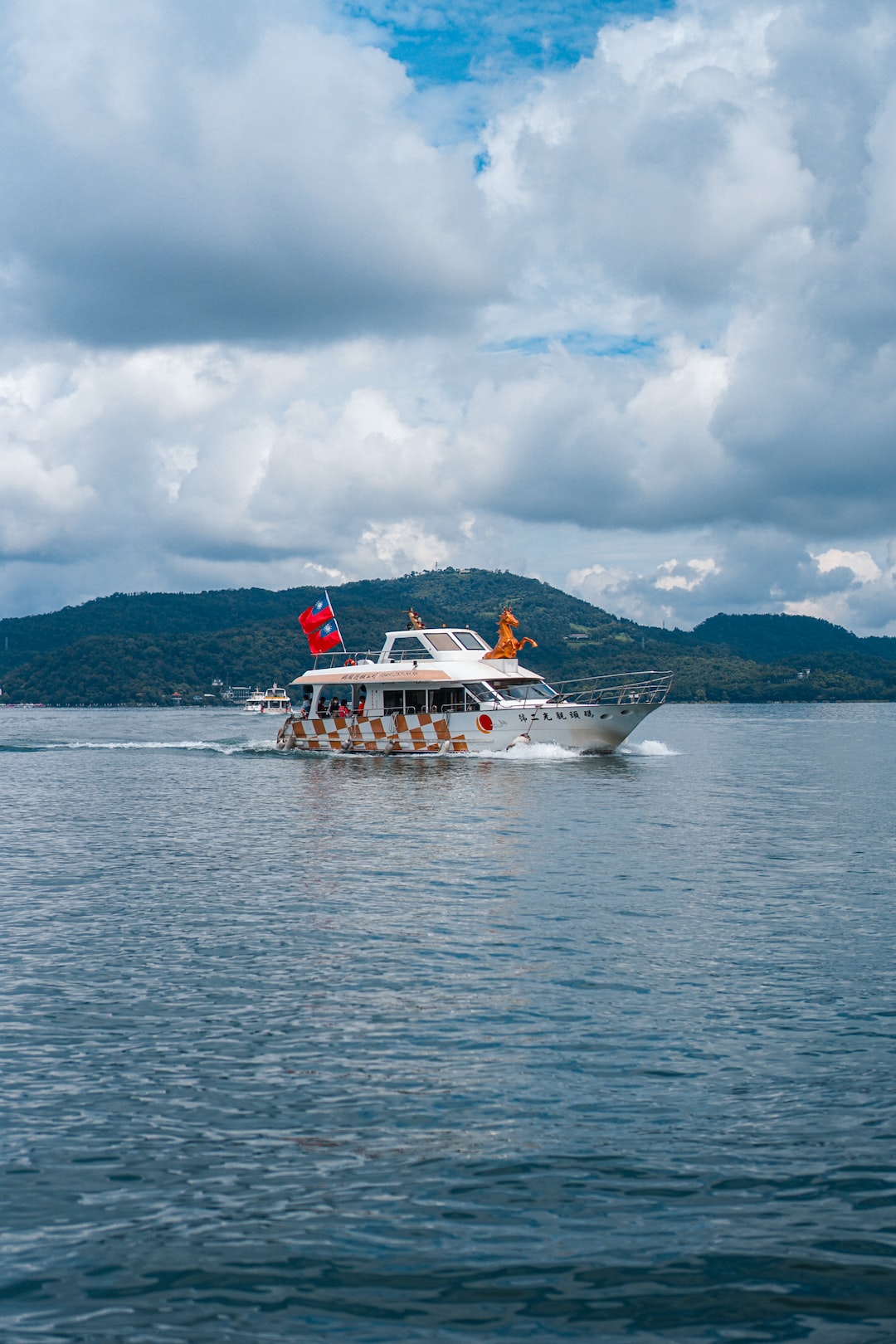
What does a hydrofoil do for a boat?
A hydrofoil lifts a boat’s hull out of the water, reducing drag and allowing the boat to glide above the surface. This results in increased speed, improved fuel efficiency, and a smoother ride.
Read more about “… What is the Purpose of a Hydrofoil? All You Need to Know About Hydrofoiling™”
How much does a hydrofoil boat cost?
The cost of a hydrofoil boat can vary greatly depending on the size, model, and features. Entry-level hydrofoil boats can start around $50,000, while high-end models can cost several million dollars.
Read more about “… Hydrofoil for Sale: Your Ultimate Guide to Hydrofoil Boarding”
What are the disadvantages of hydrofoils?
Some disadvantages of hydrofoil boats include higher costs, the need for specialized skills to operate, and reduced performance in rough conditions.
Read more about “How Does a Hydrofoil Work on an Outboard Motor? …”
How fast can a hydrofoil boat go?
Hydrofoil boats can reach impressive speeds, with some models capable of exceeding 60 knots (69 mph). The actual speed depends on factors such as the boat’s design, engine power, and water conditions.
Read more about “… Hydrofoil Speed Boat: The Future of High-Speed Water Travel”
Hydrofoil boats offer an exhilarating and efficient way to navigate the water. With their ability to glide above the surface, hydrofoil boats provide increased speed, fuel efficiency, and a smooth ride. While they may come with a higher price tag and require specialized skills, the benefits they offer make them a worthwhile investment for water sports enthusiasts and those seeking fast and comfortable transportation on the water.
So, if you’re ready to take your hydrofoil boarding to new heights, consider adding a hydrofoil boat to your arsenal. Get ready to soar above the water and experience the thrill of hydrofoil technology!
- Hydrofoil History
- Advanced Hydrofoiling Techniques
- Hydrofoil Equipment Reviews
- How Does a Hydrofoil Work on an Outboard Motor? 2023
- CHECK PRICE on: Amazon | Walmart | Etsy
- Shop Hydrofoil Boats on: Amazon | Walmart | Etsy
- Shop Hydrofoil Equipment on: Amazon | Walmart | Etsy
- Shop Hydrofoil Boards on: Amazon | Walmart | Etsy
- Shop Hydrofoil Accessories on: Amazon | Walmart | Etsy
- Shop Hydrofoil Books on: Amazon | Walmart | Etsy
- Wikipedia – Hydrofoil
- Brand Official Website
Review Team
The Popular Brands Review Team is a collective of seasoned professionals boasting an extensive and varied portfolio in the field of product evaluation. Composed of experts with specialties across a myriad of industries, the team’s collective experience spans across numerous decades, allowing them a unique depth and breadth of understanding when it comes to reviewing different brands and products.
Leaders in their respective fields, the team's expertise ranges from technology and electronics to fashion, luxury goods, outdoor and sports equipment, and even food and beverages. Their years of dedication and acute understanding of their sectors have given them an uncanny ability to discern the most subtle nuances of product design, functionality, and overall quality.
Related Posts
Can you surf waves with efoil [2024] 🌊.
- March 15, 2024
Can You Surf on a Foil Board? [2024] 🏄♂️
Can you hydrofoil on flat water [2024] ✅, leave a reply cancel reply.
Your email address will not be published. Required fields are marked *
Add Comment *
Save my name, email, and website in this browser for the next time I comment.
Post Comment
Trending now
Electric boats
Candela raises record funding to solve the biggest problem with electric boats.
The innovative Swedish electric boat maker Candela has just announced its biggest funding round ever, reeling in €24.5M (US $26.6M). Fresh off the announcement of the first commercial user of the company’s new P-12 electric ferry , Candela is now flying closer to its goal of replacing combustion engine watercraft with efficient electric boats in both the recreational and commercial boating industries.
The company is well on its way to achieving that goal, using an innovative design with computer-controlled hydrofoils that help its boats fly above the surface of the water. The hydrofoils enable the boats to use 80% less energy than comparable vessels covering the same route.
That efficiency improvement is an even bigger achievement in the water than on land, since electric cars only have to consider aerodynamics when they push air out of the way. Boats dealing with the hydrodynamic issues of much heavier water result in significantly lower efficiencies. Electric boats thus typically require incredibly powerful motors and massive battery banks. But Candela’s high-tech hydrofoils mean the boats can be much more efficient and economical with smaller motors and batteries that still achieve longer range.

And major boatbuilders seem to agree with Candela’s approach. In fact, one of the key contributing members of Candela’s latest record funding round is Groupe Beneteau, a leading global boat maker with a turnover of €1.46B, 15 factories, 9 brands, and more than 8,000 yachts built annually.
As the company explained, the move correlates with its own goals.
“Our investment perfectly aligns with Groupe Beneteau‘s ecological transition objectives, scaling up innovative solutions for more sustainable boating and unparalleled navigation experiences. Candela’s technology, enabling significantly more efficient electric vessels, will transform waterborne transport into its next sustainable phase”, said Bruno Thivoyon, CEO at Groupe Beneteau.
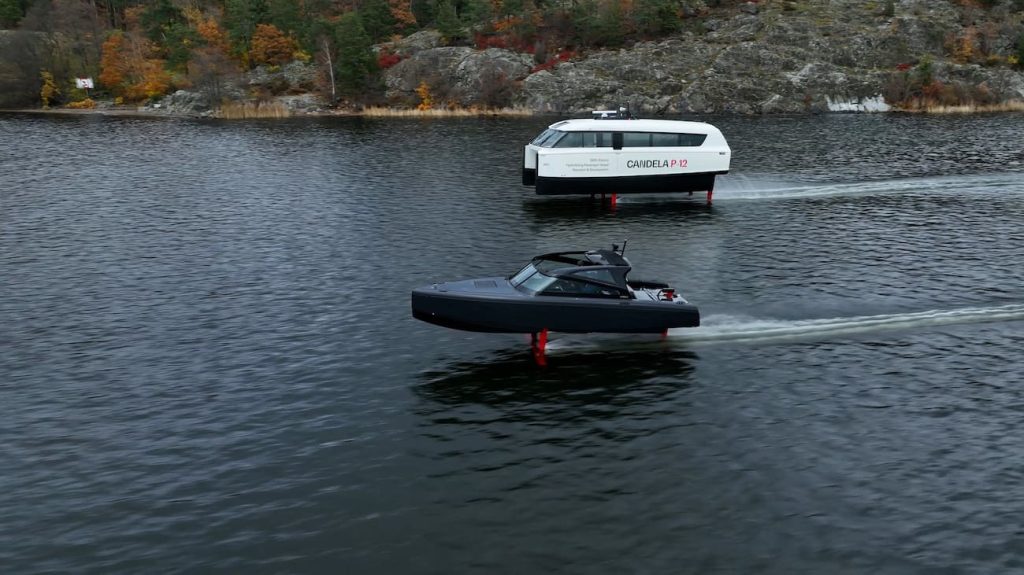
It’s a major score for Candela, as the company’s CEO Gustav Hasselskog added:
“We couldn’t be more excited about having Groupe Beneteau on board. As the leading global boat company, their trust is a stamp of approval for our technology to transform waterborne transportation. We’re excited for the possibilities ahead.”

Candela expects the new investment round to help scale up production to meet demand for the recently launched Candela P-12, the world’s first electric hydrofoil ferry.
The P-12 marks a new chapter in waterborne transport, as it’s the first fast and long-range electric ferry on the market. Its efficient hydrofoil tech cuts lifetime emissions by an impressive 97.5% compared to diesel vessels, while simultaneously cutting operators’ costs in half.
Since it generates minimal wake, the P-12 has been granted exemptions from speed limits in many no-wake areas, such as on its maiden route in Stockholm, where in July it will begin cutting travel times in half compared to road transport and legacy diesel vessels.

FTC: We use income earning auto affiliate links. More.

Micah Toll is a personal electric vehicle enthusiast, battery nerd, and author of the Amazon #1 bestselling books DIY Lithium Batteries , DIY Solar Power, The Ultimate DIY Ebike Guide and The Electric Bike Manifesto .
The e-bikes that make up Micah’s current daily drivers are the $999 Lectric XP 2.0 , the $1,095 Ride1Up Roadster V2 , the $1,199 Rad Power Bikes RadMission , and the $3,299 Priority Current . But it’s a pretty evolving list these days.
You can send Micah tips at [email protected], or find him on Twitter , Instagram , or TikTok .
Micah Toll's favorite gear

Lectric XP 3.0 e-bike sale
Best $999 electric bike ever!

Rad Power Bikes sales
Great e-bikes at great prices!

IMAGES
COMMENTS
Italian Enrico Forlanini began experimenting with foils in 1898. In 1906, his 1-ton 60 hp foiler reached 42.5 mph. Alexander Graham Bell's HD-4 Hydrodrome flew on Bras d' Or Lake at 70 mph in 1919. And several sailing foiler patents began appearing in the 1950s. Notably, JG Baker's 26-foot monohull, Monitor, flew at 30-plus mph in 1955.
Quick Answer: A hydrofoil yacht is a sailboat equipped with wing-like foils that lift the hull out of the water as it gains speed. This reduces drag, increases speed, and provides a smoother ride. Hydrofoil yachts can be retrofitted on both monohull and multihull sailboats, with different types of foils used for stability and control.
Sailing hydrofoil. A sailing hydrofoil, hydrofoil sailboat, or hydrosail is a sailboat with wing-like foils mounted under the hull. As the craft increases its speed the hydrofoils lift the hull up and out of the water, greatly reducing wetted area, resulting in decreased drag and increased speed. A sailing hydrofoil can achieve speeds exceeding ...
Then friction only acts on the small foils, not on the whole hull, which is why a 130-foot hydrofoiling sailboat can "fly" at over 50 knots. Powerboats have added friction from the propulsion system that has to remain in the water, but even then, large hydrofoiling ferries can exceed 45 knots. Speed is not the only advantage that hydrofoils ...
Ongoing innovations in foil technology continue to propel hydrofoils to new heights. ... Discover the Magic of Hydrofoil Sailboats. Hydrofoils saw their early development as a concept for enhancing speed and efficiency on the water. From Alexander Graham Bell's experiments to the application of foils on sailboats in the 1950s, the quest has ...
Hydrofoils that lift a hull entirely out of the water seem to be too alien to most boaters. Plus, most foil designs require dynamic control using computers to remain aloft at a constant elevation. But they are proven to be effective. ... On this boat, little trim is needed because the optimal angle of attack of the hydrofoil is only about 1.5 ...
Supported by an electric propulsion system and automatically actuating hydrofoils, this has become one of the most popular hydrofoil boats on the market. Price: $240,000. Power Specs: 40 hp, 40 kWh battery, capable of cruising at 22 knots. ** For a more in-depth review, check out this Youtube video: Candela C-7 Review.
Hydrofoils are hybrids of a planing monohull with a foil system. Hydrofoils were developed over 100 years now with some high-tech applications in the 1960s and 1980s. ... The clear answer is no, as hydrofoil systems have strong applications in sailboats now with extremely high tech applications reaching over 50 knots in much slower winds ...
Hydrofoiling is allowing boats to achieve speeds two or three times faster than they could in displacement mode, and it's taking sailing by storm. ... An Italian naval architect named Enrico Forlanini is credited with developing the first waterborne hydrofoils, which he affixed to a 60 hp, airscrew-driven craft that topped off at 36.9 knots ...
A foil catamaran, also known as a hydrofoil catamaran, works by utilizing hydrofoils to lift the hulls out of the water. These foils generate lift as the boat gains speed, reducing drag and allowing for faster and smoother sailing. The lift created by the foils enables the catamaran to "fly" above the water, resulting in increased speed and ...
Hydrofoil design is a crucial aspect of hydrofoil boarding. The design of a hydrofoil consists of several components, including the foil head, foil mast, fuselage, front wing, and stabilizer. These components work together to provide lift, stability, and maneuverability on the water. The type of hydrofoil design you choose will depend on your ...
Being the biggest boat in the field means that I will have a speed disadvantage over the pack of smaller boats. Having the StingRay HyperFoil 500 on my boat makes up a lot of that disadvantage by putting me on plane before the lighter boats, and allowing me to reach my top speed even faster. It also allows me to run in shallower water.
A hydrofoil is a lifting surface, or foil, that operates in water.They are similar in appearance and purpose to aerofoils used by aeroplanes. Boats that use hydrofoil technology are also simply termed hydrofoils. As a hydrofoil craft gains speed, the hydrofoils lift the boat's hull out of the water, decreasing drag and allowing greater speeds.
Overview of comparison sailing the hydrofoiled boat against the larger Oz Goose. This is not necessarily a question of speed, though it is nice to get. Our 8ft boat is absolutely sub optimal as a foil stabilised boat. It is short, so potential hull speed is low - 8ft long. This limits foil lift (square of velocity).
The Cons of Boat Hydrofoils. Despite their numerous benefits, hydrofoils do have some limitations: Limitations for Large Boats. Hydrofoils are not recommended for large boats or ships as the benefits won't be as significant. Prone to Damage. Hydrofoils are prone to damage from repeated impacts, which could lead to steering issues or accidents.
Candela, a new 25-foot production e-foiling powerboat (and 2019 Best of Boats award winner) offers such a solution with foils that change position 100 times per second! Still, at ~$240,000 it's well beyond most boating budgets. Fortunately, smaller foilers (dinghies and boards) don't require high tech flight control systems and are far less ...
Foiling refers to the use of hydrofoils attached to the hull of fast boats, which provides additional lift at planing speeds - often enough to lift the hull completely clear of the water. ... British boat designer John Thornycroft followed up with a series of scale models featuring stepped hulls and a single foil, and by 1909 had a full-scale ...
Here's How a Hydrofoil Really Works: A hydrofoil is a surface mounted beneath the boat. As a boat picks up speed, this surface generates lift and begins to rise, eventually raising the boat clear of the water. With the hull above the water's surface and no longer causing drag, the boat's speed greatly increases.
Welcome. Sailboats have been using hydrofoils to fly above the water for over 50 years. However, with the advances in materials and construction, hydrofoil sailing is becoming more common. The plan for this site are to have information on many prior hydrofoil boats as well as current and future boats. There will also be other sections on ...
However, we'll note that the Stingray Hydrofoils AIRO Hydrofoil does feature pronounced curvature for better lift on heavier small boats. 1-Piece Hydrofoils for Medium-Sized Outboard Engines The Stingray Hydrofoils Hydrofoil (left), SE Sport 200 + 300 + 400 Series Hydrofoils (middle), and Stingray Hydrofoils Starfire Hydrofoil (right).
Enata Foiler. Dubai-based Enata Marine added a healthy dose of glamour to the world of foiling boats in 2018 with the launch of its Foiler. In addition to a superyacht tender-worthy exterior, this 32fter includes a bow window for spectacular views while underway. A 40-knot top speed and a 190nm range makes this a very appealing option, although ...
A hydrofoil boat is a watercraft equipped with hydrofoils, which are wing-like structures that lift the boat's hull out of the water at high speeds. This reduces drag and allows the boat to glide smoothly above the water's surface. Hydrofoil boats offer increased speed, fuel efficiency, and a thrilling ride for water sports enthusiasts.
For boats pulling tubers, skiers, or wakeboarders the StingRay XR4 Hydrofoil helps pull them up quicker, smooths out the wake for more enjoyable towing, and increases driver visibility by getting the bow of the boat down sooner. Heavy runabouts and ocean-going center-consoles can benefit from the maximum lift provided by the StingRay XR4 Hydrofoil.
March 19, 2024 - 4:00 am. In 1906, inventor Enrico Forlanini launched the first hydrofoil boat on Lake Maggiore in the Italian alps. His contemporary innovator Alexander Bell later said a ride on ...
The hydrofoils enable the boats to use 80% less energy than comparable vessels covering the same route. That efficiency improvement is an even bigger achievement in the water than on land, since ...
80 likes, 0 comments - solarboattwente on March 12, 2024: "How do our hydrofoils change their angle? With the hinge! The hinge enables the wing to adjust its angle ...